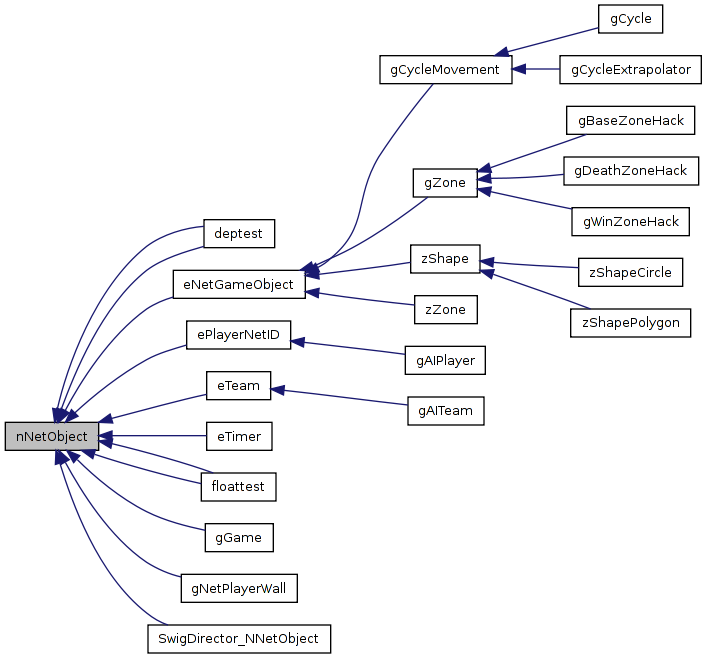
#include <nNetObject.h>

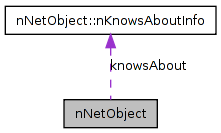
Public Member Functions | |
| virtual void | AddRef () |
| virtual void | Release () |
| int | GetRefcount () const |
| virtual void | ReleaseOwnership () |
| virtual void | TakeOwnership () |
| bool | Owned () |
| nObserver & | GetObserver () const |
| virtual void | Dump (tConsole &con) |
| unsigned short | ID () const |
| unsigned short | Owner () const |
| nMachine & | GetMachine () const |
| returns the machine this object belongs to | |
| virtual nDescriptor & | CreatorDescriptor () const =0 |
| nNetObject (int owner=-1) | |
| nNetObject (nMessage &m) | |
| virtual void | InitAfterCreation () |
| void | Register (const nNetObjectRegistrar &r) |
| virtual bool | ActionOnQuit () |
| virtual void | ActionOnDelete () |
| virtual bool | BroadcastExistence () |
| virtual void | PrintName (tString &s) const |
| bool | HasBeenTransmitted (int user) const |
| bool | syncRequested (int user) const |
| virtual bool | ClearToTransmit (int user) const |
| virtual void | WriteSync (nMessage &m) |
| virtual void | ReadSync (nMessage &m) |
| virtual void | WriteSync (nMessage &m, int run) |
| virtual void | ReadSync (nMessage &m, int run) |
| virtual bool | SyncIsNew (nMessage &m) |
| virtual void | WriteCreate (nMessage &m) |
| virtual void | WriteCreate (nMessage &m, int run) |
| virtual void | ReadCreate (nMessage &m, int run) |
| void | WriteAll (nMessage &m, bool create) |
| void | ReadAll (nMessage &m, bool create) |
| virtual void | ReceiveControlNet (nMessage &m) |
| virtual bool | AcceptClientSync () const |
| void | GetID () |
| void | RequestSync (bool ack=true) |
| void | RequestSync (int user, bool ack) |
Static Public Member Functions | |
| static bool | DoDebugPrint () |
| static nNetObject * | ObjectDangerous (int i) |
| static void | SyncAll () |
| static void | ClearAll () |
| static void | ClearAllDeleted () |
| static void | ClearKnows (int user, bool clear) |
| static void | RelabelOnConnect () |
Protected Member Functions | |
| nNetObject * | Object (int i) |
| void | DoBroadcastExistence () |
| virtual | ~nNetObject () |
| virtual nMachine & | DoGetMachine () const |
| returns the machine this object belongs to | |
| nMessage * | NewControlMessage () |
Static Protected Member Functions | |
| static int | SyncedUser () |
| returns the user that the current WriteSync() is intended for | |
Protected Attributes | |
| nKnowsAboutInfo | knowsAbout [MAXCLIENTS+2] |
Private Member Functions | |
| tCONTROLLED_PTR (nObserver) observer_ | |
Private Attributes | |
| bool | createdLocally |
| unsigned long int | lastSyncID_ |
| unsigned short | id |
| int | refCtr_ |
| unsigned short | owner |
| int | syncListID_ |
Friends | |
| class | nWaitForAckSync |
Classes | |
| class | nKnowsAboutInfo |
Definition at line 51 of file nNetObject.h.
| nNetObject::nNetObject | ( | int | owner = -1 |
) |
Definition at line 707 of file nNetObject.cpp.
References createdLocally, owner, sn_myNetID, and syncListID_.
00707 :lastSyncID_(0), 00708 id(0),refCtr_(0),owner(own){ 00709 #ifdef DEBUG 00710 //con << "Netobject " << id << " created.\n"; 00711 // if (id == 383) 00712 // st_Breakpoint(); 00713 #endif 00714 syncListID_ = -1; 00715 00716 createdLocally = true; 00717 00718 if (own<0) owner=::sn_myNetID; 00719 }
| nNetObject::nNetObject | ( | nMessage & | m | ) |
Definition at line 775 of file nNetObject.cpp.
References createdLocally, nNetObjectRegistrar::id, knowsAbout, nNetObject::nKnowsAboutInfo::knowsAboutExistence, nSERVER, nNetObjectRegistrar::object, owner, nMessage::Read(), nNetObjectRegistrar::sender, nMessage::SenderID(), sn_GetNetState(), syncListID_, and tASSERT.
00775 :lastSyncID_(m.MessageIDBig()),refCtr_(0){ 00776 // sn_Update(global_lastSync,lastSyncID_); 00777 00778 id = 0; 00779 owner = 0; 00780 00781 syncListID_ = -1; 00782 00783 tASSERT( sn_Registrar ); 00784 nNetObjectRegistrar& registrar = *sn_Registrar; 00785 00786 createdLocally = false; 00787 00788 m.Read( registrar.id ); 00789 #ifdef DEBUG 00790 //con << "Netobject " << id << " created on remote order.\n"; 00791 // if (id == 383) 00792 // st_Breakpoint(); 00793 #endif 00794 m.Read( owner ); 00795 00796 // clients are only allowed to create self-owned objects 00797 if ( sn_GetNetState() == nSERVER ) 00798 { 00799 if ( owner != m.SenderID() ) 00800 { 00801 throw nKillHim(); 00802 } 00803 } 00804 00805 registrar.object = this; 00806 registrar.sender = m.SenderID(); 00807 00808 knowsAbout[m.SenderID()].knowsAboutExistence=true; 00809 #ifdef DEBUG 00810 // con << "Netobject " << id << " created (remote order).\n"; 00811 #endif 00812 }

| nNetObject::~nNetObject | ( | ) | [protected, virtual] |
Definition at line 984 of file nNetObject.cpp.
References tRecorderSync< DATA >::Archive(), createdLocally, knowsAbout, MAXCLIENTS, net_destroy, nSERVER, NULL, owner, refCtr_, tList< T, MALLOC, REFERENCE >::Remove(), nDeletedInfo::Set(), sn_GetNetState(), sn_myNetID, sn_netObjects, syncListID_, tCHECK_DEST, tERR_ERROR, and tSysTimeFloat().
00984 { 00985 // remove from sync list 00986 if ( syncListID_ >= 0 ) 00987 sn_SyncRequestedObject.Remove( this, syncListID_ ); 00988 00989 // release observer 00990 if ( this->observer_ ) 00991 { 00992 this->observer_->SetObject( NULL ); 00993 } 00994 00995 #ifdef DEBUG 00996 int extra=0; 00997 00998 // account for the reference held by the creator of the object 00999 01000 // only if the object is validly entered in our object-array 01001 if (id > 0 && static_cast<nNetObject*>(sn_netObjects[id])==this) 01002 { 01003 if ( createdLocally ) 01004 extra = -1; 01005 } 01006 01007 if (refCtr_ + extra > 0) 01008 tERR_ERROR("Hey! There is stil someone interested in this nNetObject!\n"); 01009 //con << "Netobject " << id << " deleted.\n"; 01010 #endif 01011 01012 // mark id as soon-to-be free 01013 if (id) 01014 { 01015 #ifdef DEBUG 01016 sn_BreakOnObjectID( id ); 01017 #endif 01018 if ( sn_GetNetState() == nSERVER ) 01019 { 01020 sn_netObjectsOwner[id]=0xFFFF; 01021 sn_freedIDs.push_back( id ); 01022 } 01023 else 01024 { 01025 sn_netObjectsOwner[id]=0; 01026 } 01027 } 01028 01029 // determine whether a destroy message should be sent: the server definitely should... 01030 bool sendDestroyMessage = (sn_GetNetState()==nSERVER); 01031 if (!sendDestroyMessage && id && sn_netObjects_AcceptClientSync[id] && owner==sn_myNetID) 01032 { 01033 // ... but also the client if the object belongs to it. 01034 sendDestroyMessage = true; 01035 01036 // the server will send a response destroy message later. We need to ignore it. 01037 sn_LocallyDestroyedIDs.insert(id); 01038 } 01039 01040 // send it 01041 if ( sendDestroyMessage ) 01042 { 01043 int idsync=id; 01044 tRecorderSync< int >::Archive( "_NETOBJECT_DESTROYED", 3, idsync ); 01045 01046 // con << "Destroying object " << id << '\n'; 01047 for (int user=MAXCLIENTS;user>=0;user--){ 01048 if (user!=sn_myNetID && knowsAbout[user].knowsAboutExistence || 01049 knowsAbout[user].acksPending){ 01050 if (destroyers[user]==NULL) 01051 { 01052 destroyers[user]=new nMessage(net_destroy); 01053 destroyersTime[user]=tSysTimeFloat(); 01054 } 01055 destroyers[user]->Write(id); 01056 01057 if (destroyers[user]->DataLen()>100){ 01058 destroyers[user]->Send(user); 01059 destroyers[user]=NULL; 01060 } 01061 01062 #ifdef DEBUG 01063 //con << "remotely destroying object " << id << '\n'; 01064 #endif 01065 } 01066 } 01067 } 01068 refCtr_=100; 01069 if (id) 01070 { 01071 if (this == sn_netObjects[id]) 01072 { 01073 #ifdef DEBUG 01074 sn_BreakOnObjectID( id ); 01075 #endif 01076 sn_netObjects[id] = NULL; 01077 } 01078 01079 // clear object from info arrays 01080 nDeletedInfos::iterator found = sn_netObjectsDeleted.find( id ); 01081 if ( found != sn_netObjectsDeleted.end() ) 01082 { 01083 nDeletedInfo & deleted = (*found).second; 01084 deleted.Set( NULL ); 01085 sn_netObjectsDeleted.erase(found); 01086 } 01087 } 01088 01089 refCtr_=-100; 01090 tCHECK_DEST; 01091 }

| nNetObject::tCONTROLLED_PTR | ( | nObserver | ) | [mutable, private] |
| nNetObject * nNetObject::Object | ( | int | i | ) | [protected] |
Definition at line 1095 of file nNetObject.cpp.
References Cheater(), con, nReadError(), nSERVER, NULL, ObjectDangerous(), owner, REAL, sn_Connections, sn_GetNetState(), sn_netObjects, sn_Receive(), sn_SendPlanned(), tAdvanceFrame(), tERR_WARN, and tSysTimeFloat().
Referenced by _wrap_GSimpleAI_object(), deptest::deptest(), eNetGameObject::eNetGameObject(), and gNetPlayerWall::gNetPlayerWall().
01095 { 01096 if (i==0) // the NULL nNetObject 01097 return NULL; 01098 01099 // the last deleted object with specified ID 01100 nNetObject* deleted = NULL; 01101 nDeletedInfos::const_iterator found = sn_netObjectsDeleted.find( id ); 01102 if ( found != sn_netObjectsDeleted.end() ) 01103 { 01104 deleted = (*found).second.object_; 01105 } 01106 01107 // return immediately if the object is there 01108 nNetObject *ret=ObjectDangerous( i ); 01109 if ( ret ) 01110 { 01111 return ret; 01112 } 01113 01114 // set new timeout value 01115 const REAL totalTimeout=10; 01116 const REAL printMessageTimeout=.5; 01117 01118 double newTimeout=tSysTimeFloat()+totalTimeout; 01119 static double timeout=-1; 01120 if ( tSysTimeFloat() > timeout ) 01121 timeout = newTimeout; 01122 01123 bool printMessage=true; 01124 while (sn_Connections[0].socket && 01125 NULL==(ret=sn_netObjects[i]) && timeout >tSysTimeFloat()){ // wait until it is spawned 01126 if (tSysTimeFloat()>timeout-(totalTimeout + printMessageTimeout)) 01127 { 01128 if (printMessage) 01129 { 01130 con << "Waiting for NetObject with ID " << i << " to spawn...\n"; 01131 printMessage=false; 01132 } 01133 if (sn_GetNetState()==nSERVER){ 01134 // in server mode, we cannot wait. 01135 01136 // the deleted object with the same ID must have been meant 01137 if ( deleted ) 01138 { 01139 return deleted; 01140 } 01141 01142 nReadError(); 01143 01144 con << "Now we need to leave the\n" 01145 << "system in an undefined state. I hope this works...\n"; 01146 01147 Cheater(owner); // kill this bastard 01148 return NULL; // pray that noone references this pointer 01149 } 01150 } 01151 tAdvanceFrame(10000); 01152 sn_Receive(); 01153 sn_SendPlanned(); 01154 } 01155 01156 if (!ret) 01157 ret = deleted; 01158 01159 if (!ret) 01160 tERR_WARN("Netobject " << i << " requested, but was never spawned."); 01161 01162 return ret; 01163 }
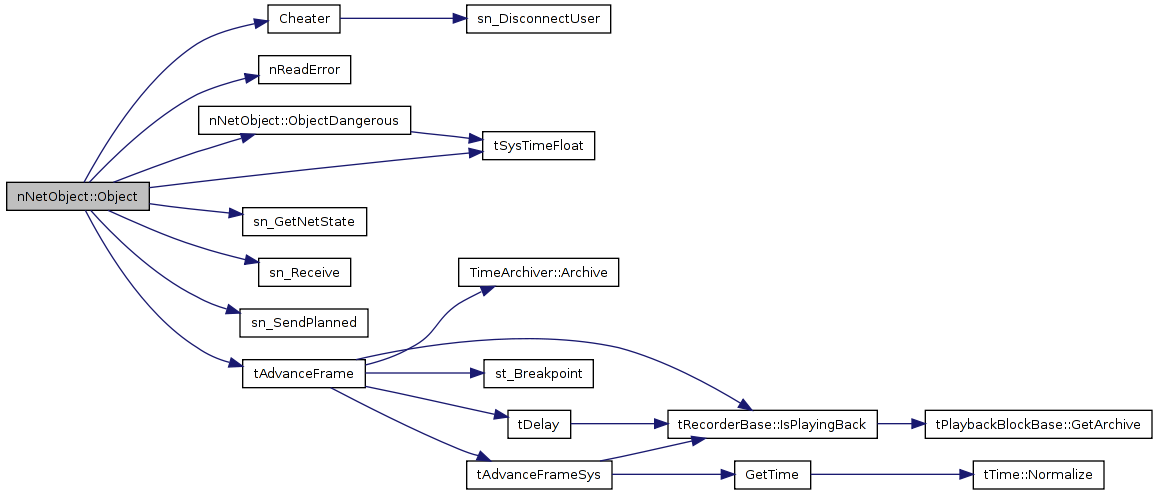

| void nNetObject::DoBroadcastExistence | ( | ) | [protected] |
Definition at line 814 of file nNetObject.cpp.
References AcceptClientSync(), BroadcastExistence(), knowsAbout, MAXCLIENTS, nCLIENT, nSERVER, owner, RequestSync(), sn_Connections, sn_GetNetState(), and sn_myNetID.
Referenced by ClearKnows(), InitAfterCreation(), and RelabelOnConnect().
00814 { 00815 if (BroadcastExistence() && 00816 ( sn_GetNetState()!=nCLIENT || 00817 ( owner == ::sn_myNetID && AcceptClientSync() ) 00818 ) 00819 ) 00820 { 00821 int maxUser = (sn_GetNetState() == nSERVER) ? MAXCLIENTS : 0; 00822 int minUser = (sn_GetNetState() == nSERVER) ? 1 : 0; 00823 for (int user = maxUser; user >= minUser; --user) 00824 { 00825 // sync the object only to users that don't know about it yet 00826 if ( !knowsAbout[user].knowsAboutExistence && sn_Connections[user].socket ) // && !knowsAbout[user].syncReq ) 00827 RequestSync( user, true ); 00828 } 00829 } 00830 }
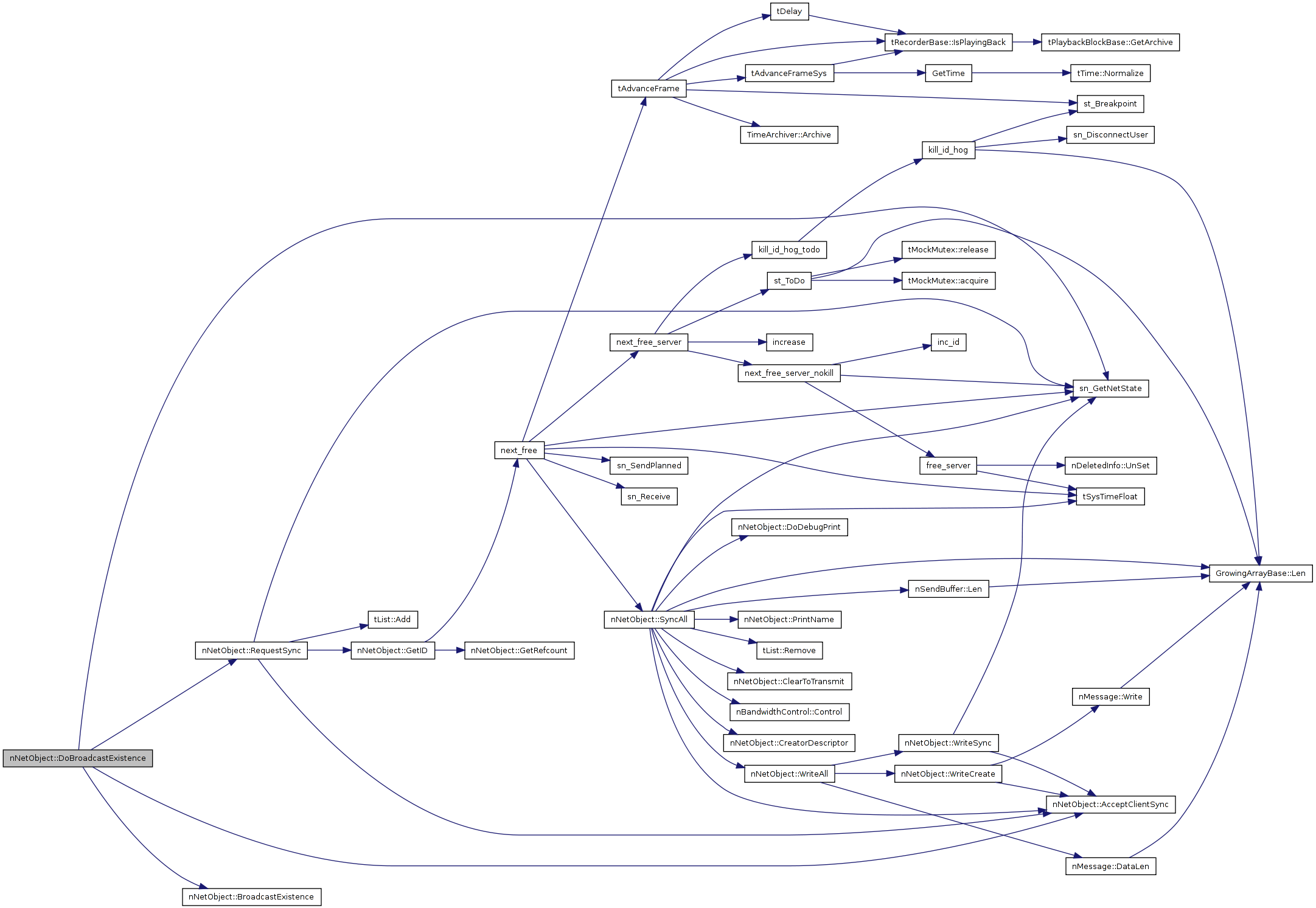

| bool nNetObject::DoDebugPrint | ( | ) | [static] |
Definition at line 1512 of file nNetObject.cpp.
Referenced by _wrap_NNetObject_do_debug_print(), gNetPlayerWall::ClearToTransmit(), eNetGameObject::ClearToTransmit(), and SyncAll().
01513 { 01514 return s_DoPrintDebug; 01515 }
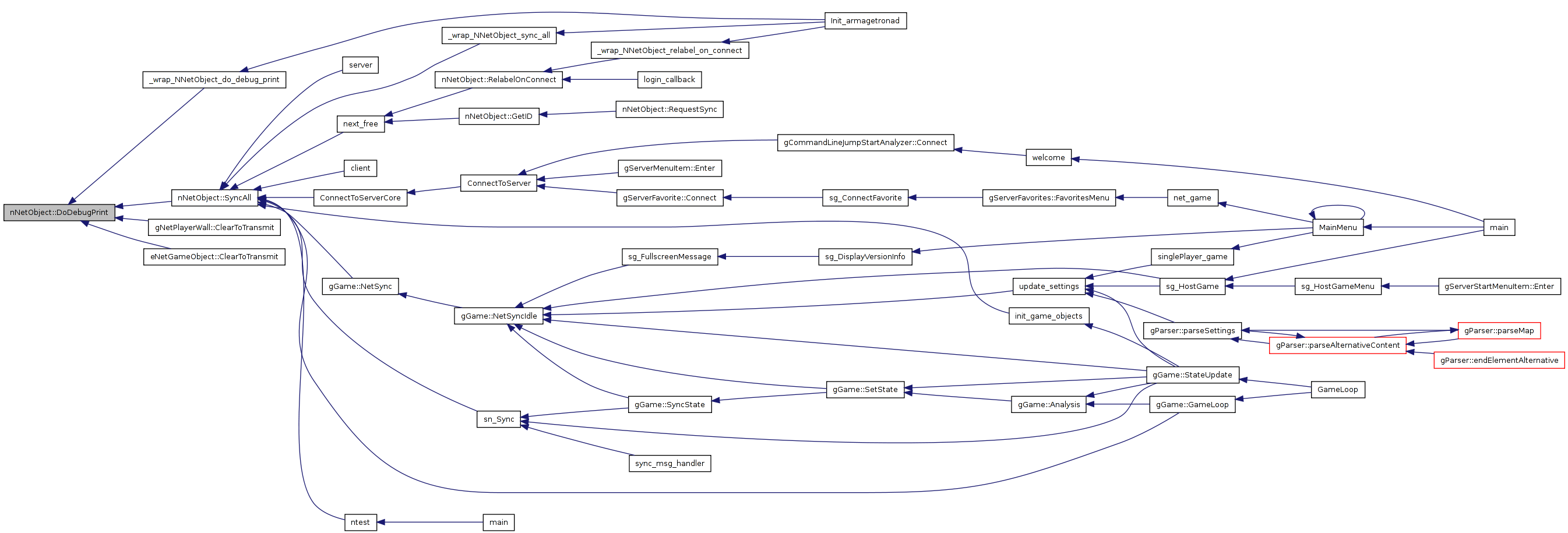
| nNetObject * nNetObject::ObjectDangerous | ( | int | i | ) | [static] |
Definition at line 1166 of file nNetObject.cpp.
References NULL, nDeletedInfo::object_, sn_netObjects, nDeletedInfo::time_, and tSysTimeFloat().
Referenced by _wrap_NNetObject_object_dangerous(), eVoteItemHarm::DoFillFromMessage(), handle_chat_client(), net_sync_handler(), new_destination_handler(), Object(), and operator>>().
01166 { 01167 if (i==0) // the NULL nNetObject 01168 { 01169 return NULL; 01170 } 01171 else 01172 { 01173 nNetObject* ret = sn_netObjects[i]; 01174 if ( ret ) 01175 { 01176 return ret; 01177 } 01178 else 01179 { 01180 nDeletedInfos::const_iterator found = sn_netObjectsDeleted.find( i ); 01181 if ( found != sn_netObjectsDeleted.end() ) 01182 { 01183 nDeletedInfo const & deleted = (*found).second; 01184 if ( deleted.time_ > tSysTimeFloat() - nDeletedTimeout ) 01185 { 01186 return deleted.object_; 01187 } 01188 } 01189 } 01190 } 01191 01192 return NULL; 01193 }


| void nNetObject::AddRef | ( | void | ) | [virtual] |
Reimplemented in eNetGameObject, SwigDirector_NNetObject, and gCycleMovement.
Definition at line 555 of file nNetObject.cpp.
References refCtr_, and tASSERT.
Referenced by _wrap_NNetObject_add_ref(), and eNetGameObject::AddRef().
00555 { 00556 tASSERT ( this ); 00557 00558 if ( this ) 00559 { 00560 tASSERT( refCtr_ >= 0 ); 00561 refCtr_++; 00562 tASSERT( refCtr_ >= 0 ); 00563 } 00564 }

| void nNetObject::Release | ( | ) | [virtual] |
Reimplemented in eNetGameObject, and SwigDirector_NNetObject.
Definition at line 582 of file nNetObject.cpp.
References createdLocally, refCtr_, sn_netObjects, tASSERT, and tERR_ERROR.
Referenced by _wrap_NNetObject_release(), eNetGameObject::Release(), and ReleaseOwnership().
00582 { 00583 tASSERT( this ); 00584 00585 if (this){ 00586 if (refCtr_>0) 00587 refCtr_--; 00588 else 00589 { 00590 #ifdef DEBUG 00591 tERR_ERROR("Negative recfcount!"); 00592 #else 00593 return; 00594 #endif 00595 } 00596 int extra=0; 00597 00598 // account for the reference held by the creator of the object 00599 00600 // only if the object is validly entered in our object-array 00601 if (id > 0 && static_cast<nNetObject*>(sn_netObjects[id])==this) 00602 { 00603 if ( createdLocally ) 00604 extra = -1; 00605 } 00606 // else 00607 // extra = -1; 00608 00609 if ( refCtr_ + extra <= 0 ) 00610 { 00611 refCtr_ = -100; 00612 delete this; 00613 } 00614 } 00615 }

| int nNetObject::GetRefcount | ( | ) | const |
Definition at line 618 of file nNetObject.cpp.
References createdLocally, refCtr_, and sn_netObjects.
Referenced by gCycleMovement::AddRef(), gAITeam::BalanceWithAIs(), GetID(), and gAIPlayer::SetNumberOfAIs().
00619 { 00620 int extra=0; 00621 00622 // account for the reference held by the creator of the object 00623 00624 // only if the object is validly entered in our object-array 00625 if (id > 0 && static_cast<nNetObject*>(sn_netObjects[id])==this) 00626 { 00627 if ( createdLocally ) 00628 extra = -1; 00629 } 00630 // else 00631 // extra = -1; 00632 00633 return this->refCtr_ + extra; 00634 }

| void nNetObject::ReleaseOwnership | ( | ) | [virtual] |
Reimplemented in SwigDirector_NNetObject.
Definition at line 566 of file nNetObject.cpp.
References createdLocally, and Release().
Referenced by _wrap_NNetObject_release_ownership().
00566 { 00567 if ( this->createdLocally ) 00568 { 00569 this->createdLocally = false; 00570 Release(); 00571 } 00572 }


| void nNetObject::TakeOwnership | ( | ) | [virtual] |
Reimplemented in SwigDirector_NNetObject.
Definition at line 574 of file nNetObject.cpp.
References createdLocally.
Referenced by _wrap_NNetObject_take_ownership(), gNetPlayerWall::ActionOnQuit(), and gCycle::ActionOnQuit().
00574 { 00575 if ( !this->createdLocally ) 00576 { 00577 this->createdLocally = true; 00578 // AddRef(); 00579 } 00580 }

| bool nNetObject::Owned | ( | ) | [inline] |
< returns whether the object is owned by this machine
Definition at line 127 of file nNetObject.h.
References createdLocally.
Referenced by _wrap_NNetObject_owned().
00127 { 00128 return createdLocally; 00129 }

| nObserver & nNetObject::GetObserver | ( | ) | const |
Definition at line 636 of file nNetObject.cpp.
References tNEW.
Referenced by _wrap_NNetObject_get_observer().
00637 { 00638 if ( !this->observer_ ) 00639 { 00640 this->observer_ = tNEW( nObserver ); 00641 this->observer_->SetObject( this ); 00642 } 00643 00644 return *this->observer_; 00645 }

| void nNetObject::Dump | ( | tConsole & | con | ) | [virtual] |
Reimplemented in SwigDirector_NNetObject.
Definition at line 649 of file nNetObject.cpp.
References PrintName().
Referenced by _wrap_NNetObject_dump().


| unsigned short nNetObject::ID | ( | ) | const [inline] |
Definition at line 135 of file nNetObject.h.
References id.
Referenced by BroadCastNewDestination(), gNetPlayerWall::ClearToTransmit(), eNetGameObject::ClearToTransmit(), zValidator::isOwner(), zValidator::isTeamOwner(), gCycle::OnDropTempWall(), gCycle::PrintName(), se_NewChatMessage(), se_ServerControlledChatMessageConsole(), ePlayerNetID::SetTeamname(), gCycle::Timestep(), and deptest::WriteCreate().
00135 { 00136 if (this) 00137 return id; 00138 else 00139 return 0; 00140 }
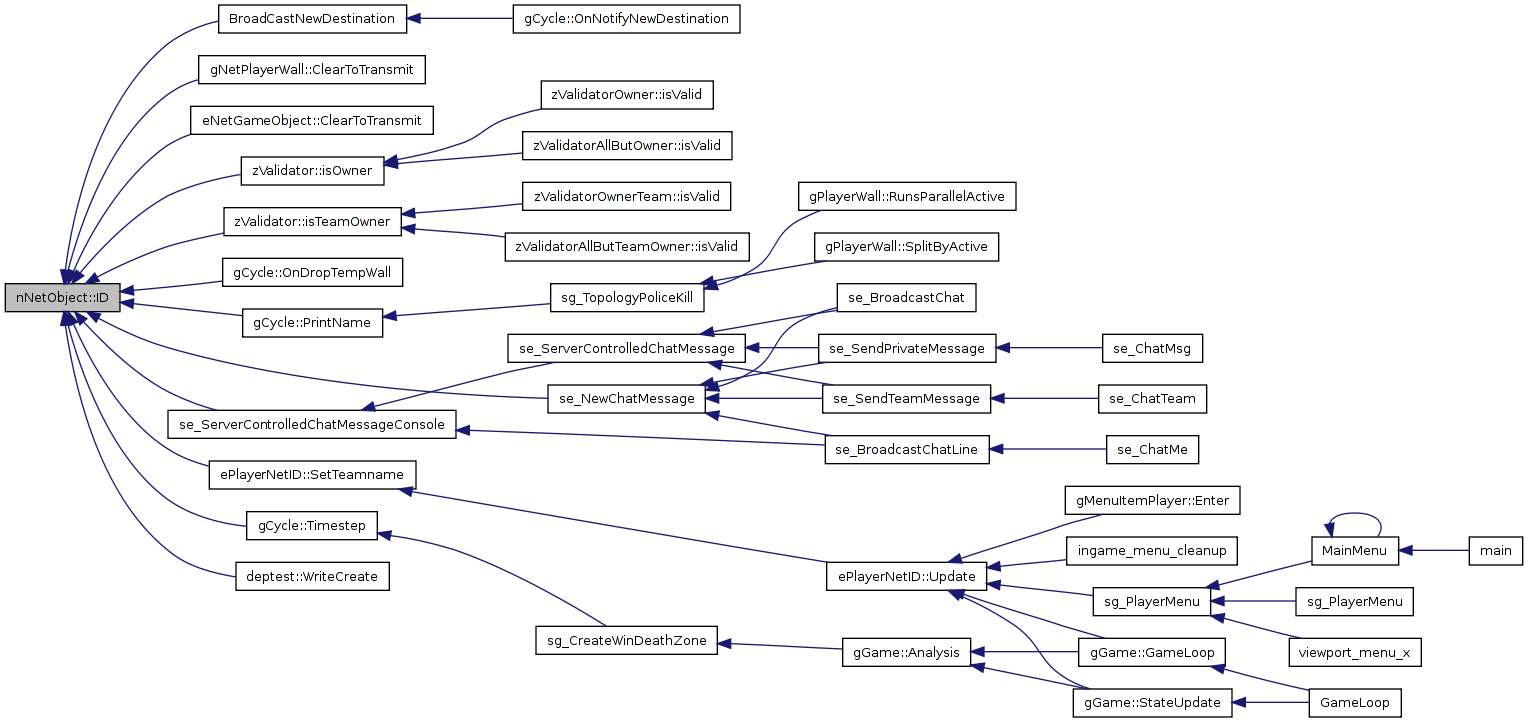
| unsigned short nNetObject::Owner | ( | ) | const [inline] |
Definition at line 142 of file nNetObject.h.
References owner, and sn_myNetID.
Referenced by gDestination::CopyFrom(), ePlayerNetID::CreateNewTeam(), ePlayerNetID::CreateVoter(), eVoteItemKick::DoCheckValid(), DoGetMachine(), gCycle::DoTurn(), gCycle::EdgeIsDangerous(), ePlayerNetID::Enemies(), ePlayerNetID::FindPlayerByName(), GameLoop(), eVoter::GetVoter(), eVoter::HandleChat(), IsSilencedWithWarning(), eNetGameObject::LagThreshold(), ePlayerNetID::MyInitAfterCreation(), eVoter::Name(), net_control_handler(), net_sync_handler(), new_destination_handler(), gCycleMovement::OnNotifyNewDestination(), gCycle::OnNotifyNewDestination(), gCycle::ReadSync(), gNetPlayerWall::RealWallReceived(), ePlayerNetID::ReceiveControlNet(), ePlayerNetID::RemoveChatbots(), nAuthentication::RequestLogin(), gCycle::RequestSyncAll(), gCycle::RequestSyncOwner(), gCycle::RightBeforeDeath(), se_ChatMsg(), se_ChatShuffle(), se_ChatState(), se_ChatTeam(), se_ChatTeamLeave(), se_FindPlayerInChatCommand(), se_GetAccessLevel(), se_GetAlivePlayerFromUserID(), se_GetLocalPlayer(), se_GetPing(), se_ListPlayers(), se_ReadUser(), se_RequestLogin(), se_SendPrivateMessage(), se_SendTeamMessage(), se_SendTo(), se_VoteKickPlayer(), eNetGameObject::SendControl(), eNetGameObject::SetPlayer(), ePlayerNetID::SetTeam(), ePlayerNetID::SetTeamWish(), sg_GetSyncIntervalSelf(), sg_UseAntiLagSliding(), sn_DoDestroy(), gCycle::SyncEnemy(), eNetGameObject::SyncIsNew(), ePlayerNetID::TeamChangeAllowed(), gCycleMovement::Timestep(), eNetGameObject::Timestep(), gCycleMovement::TimestepCore(), gCycle::TimestepCore(), ePlayerNetID::Update(), ePlayerNetID::UpdateName(), and ePlayerNetID::UpdateTeam().
00142 { 00143 if (this) 00144 return owner; 00145 else 00146 return ::sn_myNetID; 00147 }
| nMachine & nNetObject::GetMachine | ( | void | ) | const [inline] |
returns the machine this object belongs to
Definition at line 448 of file nNetObject.h.
References DoGetMachine().
Referenced by _wrap_NNetObject_get_machine(), eNetGameObject::DoGetMachine(), ePlayerNetID::Enemies(), and se_ListPlayers().
00449 { 00450 return DoGetMachine(); 00451 }


| virtual nDescriptor& nNetObject::CreatorDescriptor | ( | ) | const [pure virtual] |
Implemented in ePlayerNetID, eTeam, eTimer, floattest, deptest, floattest, deptest, SwigDirector_NNetObject, gAIPlayer, gAITeam, gCycleExtrapolator, gCycle, gGame, gNetPlayerWall, gZone, zShapeCircle, zShapePolygon, and zZone.
Referenced by nBandwidthTaskCreate::DoExecute(), new_destination_handler(), and SyncAll().

| void nNetObject::InitAfterCreation | ( | void | ) | [virtual] |
Reimplemented in eNetGameObject, ePlayerNetID, SwigDirector_NNetObject, gCycle, gCycleMovement, and gNetPlayerWall.
Definition at line 859 of file nNetObject.cpp.
References DoBroadcastExistence(), and sn_WasDeletedLocally().
Referenced by _wrap_NNetObject_init_after_creation(), gNetPlayerWall::InitAfterCreation(), and eNetGameObject::InitAfterCreation().
00859 { 00860 DoBroadcastExistence(); 00861 // con << "InitAfterCreation\n"; 00862 00863 #ifdef DEBUG 00864 sn_BreakOnObjectID( id ); 00865 #endif 00866 00867 // it just got created, all local deletions must be fakes 00868 sn_WasDeletedLocally( id ); 00869 } // after remote creation,
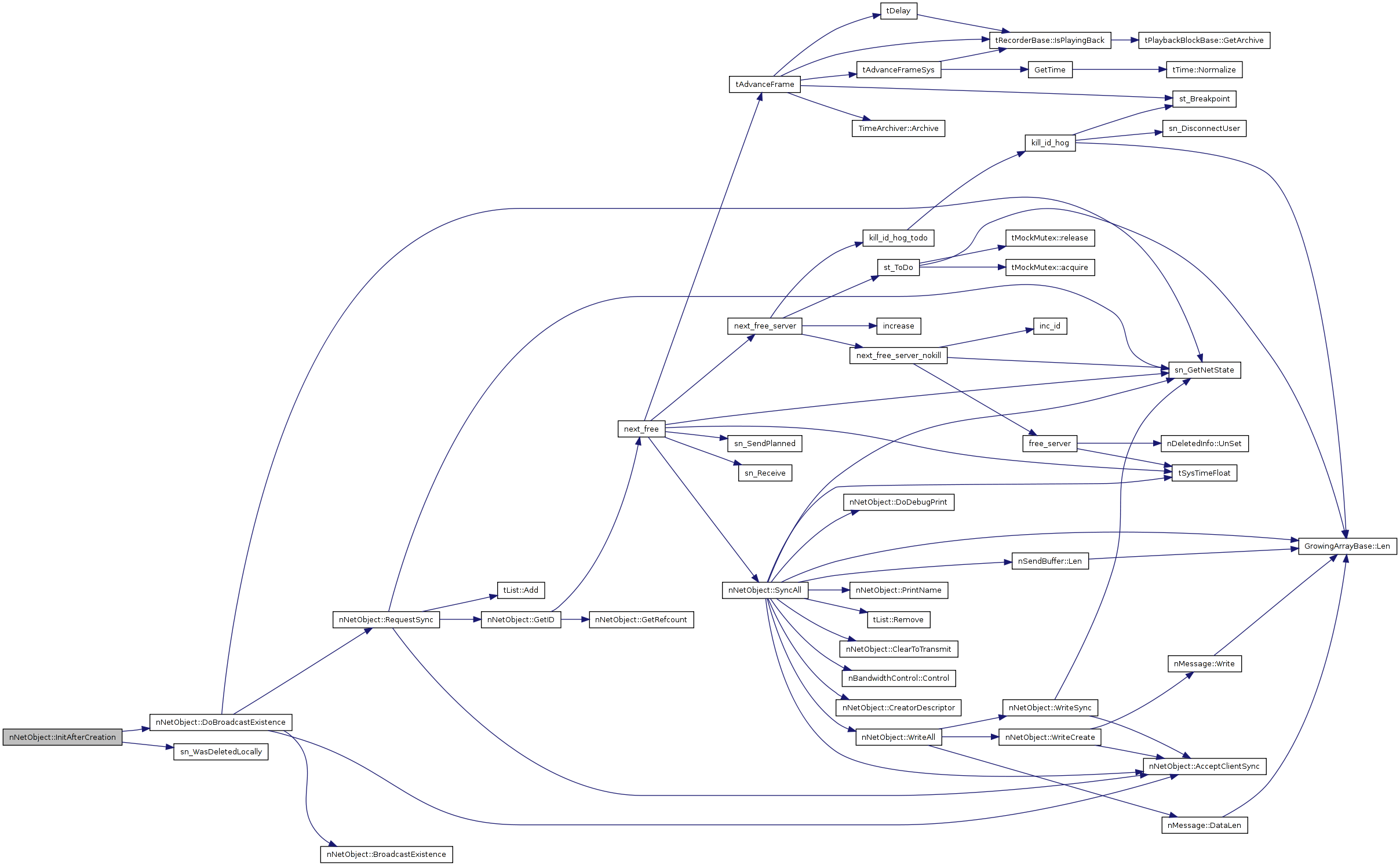

| void nNetObject::Register | ( | const nNetObjectRegistrar & | r | ) |
Definition at line 738 of file nNetObject.cpp.
References Cheater(), con, nNetObjectRegistrar::id, nCLIENT, nReadError(), nNetObjectRegistrar::object, owner, nNetObjectRegistrar::sender, sn_GetNetState(), sn_netObjects, and tASSERT.
00739 { 00740 tASSERT( this == registrar.object ); 00741 tASSERT( id == 0 || id == registrar.id ); 00742 00743 if ( this->id == registrar.id ) 00744 { 00745 return; 00746 } 00747 00748 id = registrar.id; 00749 00750 if (sn_netObjectsOwner[id]!= registrar.sender || sn_netObjects[id]){ 00751 #ifdef DEBUG 00752 con << "Netobject " << id << " is already reserved!\n"; 00753 #endif 00754 if (sn_netObjectsOwner[id]!=registrar.sender){ 00755 Cheater( registrar.sender ); 00756 nReadError(); 00757 } 00758 } 00759 else 00760 { 00761 #ifdef DEBUG 00762 sn_BreakOnObjectID( id ); 00763 #endif 00764 sn_netObjects[id]=this; 00765 } 00766 00767 if (sn_GetNetState()!=nCLIENT) 00768 owner=registrar.sender; // to make sure noone is given a nNetObject from 00769 // someone else. 00770 00771 sn_netObjectsOwner[id]=owner; 00772 sn_netObjects_AcceptClientSync[id]=false; 00773 }

| nMachine & nNetObject::DoGetMachine | ( | void | ) | const [protected, virtual] |
returns the machine this object belongs to
Reimplemented in eNetGameObject, ePlayerNetID, and SwigDirector_NNetObject.
Definition at line 2082 of file nNetObject.cpp.
References nMachine::GetMachine(), and Owner().
Referenced by ePlayerNetID::DoGetMachine(), eNetGameObject::DoGetMachine(), SwigDirector_NNetObject::DoGetMachineSwigPublic(), GetMachine(), and ePlayerNetID::RegisterWithMachine().
02083 { 02084 return nMachine::GetMachine( Owner() ); 02085 }


| virtual bool nNetObject::ActionOnQuit | ( | ) | [inline, virtual] |
Reimplemented in eNetGameObject, ePlayerNetID, SwigDirector_NNetObject, gCycle, and gNetPlayerWall.
Definition at line 184 of file nNetObject.h.
Referenced by _wrap_NNetObject_action_on_quit(), and ClearKnows().

| virtual void nNetObject::ActionOnDelete | ( | ) | [inline, virtual] |
Reimplemented in eNetGameObject, ePlayerNetID, and SwigDirector_NNetObject.
Definition at line 189 of file nNetObject.h.
Referenced by _wrap_NNetObject_action_on_delete(), and sn_DoDestroy().

| virtual bool nNetObject::BroadcastExistence | ( | ) | [inline, virtual] |
Reimplemented in SwigDirector_NNetObject.
Definition at line 194 of file nNetObject.h.
Referenced by _wrap_NNetObject_broadcast_existence(), and DoBroadcastExistence().

| void nNetObject::PrintName | ( | tString & | s | ) | const [virtual] |
Reimplemented in ePlayerNetID, eTeam, SwigDirector_NNetObject, gCycle, and gNetPlayerWall.
Definition at line 1195 of file nNetObject.cpp.
References id.
Referenced by Dump(), and SyncAll().
01196 { 01197 s << "Nameless NetObject nr. " << id; 01198 }

| bool nNetObject::HasBeenTransmitted | ( | int | user | ) | const |
Definition at line 1200 of file nNetObject.cpp.
References knowsAbout.
Referenced by deptest::ClearToTransmit(), and gGame::GridIsReady().
01200 { 01201 return (knowsAbout[user].knowsAboutExistence); 01202 }

| bool nNetObject::syncRequested | ( | int | user | ) | const [inline] |
Definition at line 203 of file nNetObject.h.
References knowsAbout, and nNetObject::nKnowsAboutInfo::syncReq.
00203 { 00204 return knowsAbout[user].syncReq; 00205 }
| bool nNetObject::ClearToTransmit | ( | int | user | ) | const [virtual] |
Reimplemented in eNetGameObject, ePlayerNetID, eTeam, deptest, deptest, SwigDirector_NNetObject, and gNetPlayerWall.
Definition at line 1206 of file nNetObject.cpp.
Referenced by _wrap_NNetObject_clear_to_transmit(), gNetPlayerWall::ClearToTransmit(), deptest::ClearToTransmit(), eNetGameObject::ClearToTransmit(), and SyncAll().

| void nNetObject::WriteSync | ( | nMessage & | m | ) | [virtual] |
Reimplemented in eNetGameObject, ePlayerNetID, eTeam, eTimer, floattest, floattest, SwigDirector_NNetObject, gCycle, gGame, gNetPlayerWall, gZone, zShape, zShapeCircle, and zZone.
Definition at line 1278 of file nNetObject.cpp.
References AcceptClientSync(), nSERVER, sn_GetNetState(), and tERR_ERROR.
Referenced by _wrap_NNetObject_write_sync(), WriteAll(), gNetPlayerWall::WriteSync(), gGame::WriteSync(), WriteSync(), floattest::WriteSync(), eTimer::WriteSync(), and eNetGameObject::WriteSync().
01278 { 01279 #ifdef DEBUG 01280 if (sn_GetNetState()!=nSERVER && !AcceptClientSync()) 01281 tERR_ERROR("WriteSync should only be called server-side!"); 01282 #endif 01283 } // nothing to do yet

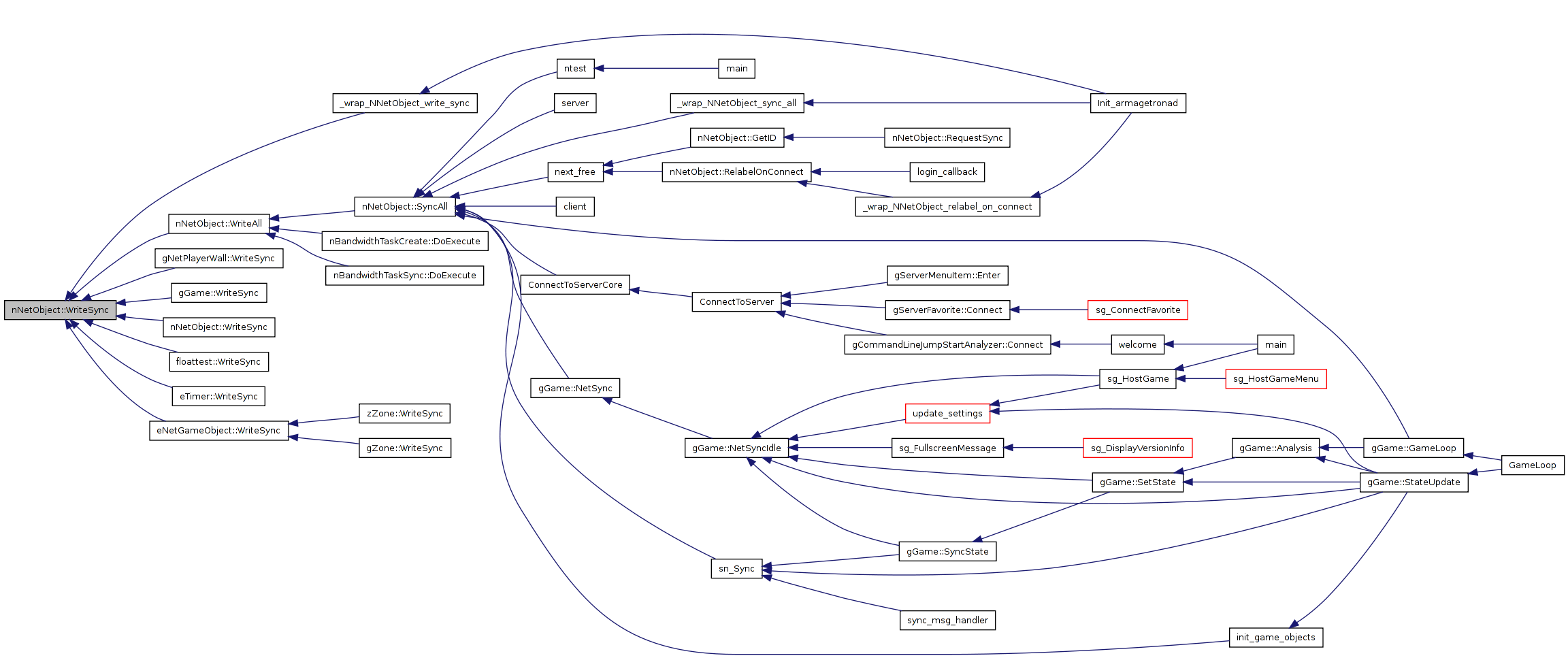
| void nNetObject::ReadSync | ( | nMessage & | m | ) | [virtual] |
Reimplemented in eNetGameObject, ePlayerNetID, eTeam, eTimer, floattest, floattest, SwigDirector_NNetObject, gCycle, gGame, gNetPlayerWall, gZone, zShape, zShapeCircle, and zZone.
Definition at line 1287 of file nNetObject.cpp.
References knowsAbout, nSERVER, RequestSync(), nMessage::SenderID(), sn_GetNetState(), and nNetObject::nKnowsAboutInfo::syncReq.
Referenced by _wrap_NNetObject_read_sync(), ReadAll(), gNetPlayerWall::ReadSync(), gGame::ReadSync(), ReadSync(), floattest::ReadSync(), eTimer::ReadSync(), eNetGameObject::ReadSync(), and floattest::ReceiveControl().
01287 { 01288 if (sn_GetNetState()==nSERVER){ 01289 bool back=knowsAbout[m.SenderID()].syncReq; 01290 RequestSync(); // tell the others about it 01291 knowsAbout[m.SenderID()].syncReq=back; 01292 // but not the sender of the message; he 01293 // knows already. 01294 } 01295 }
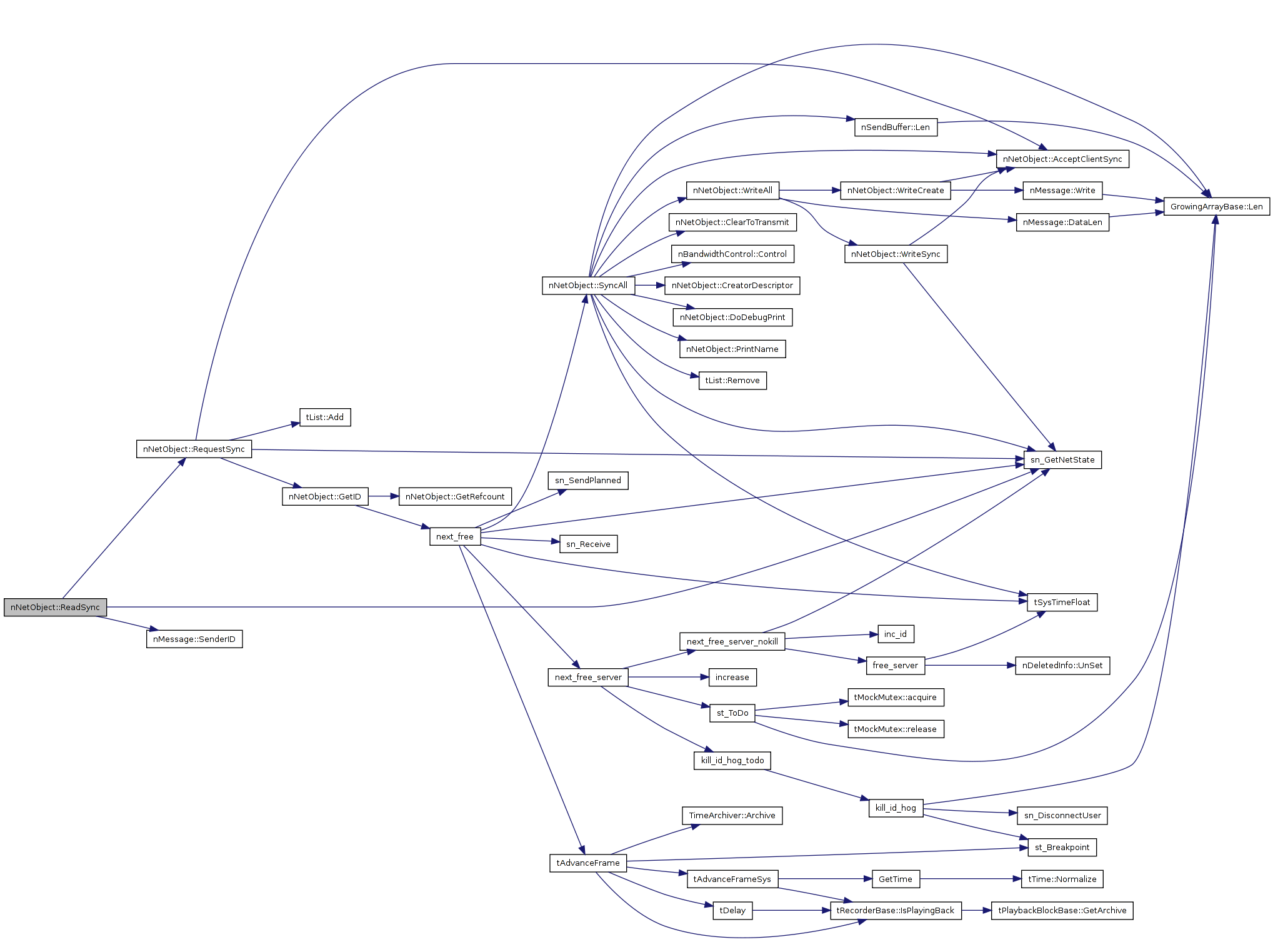
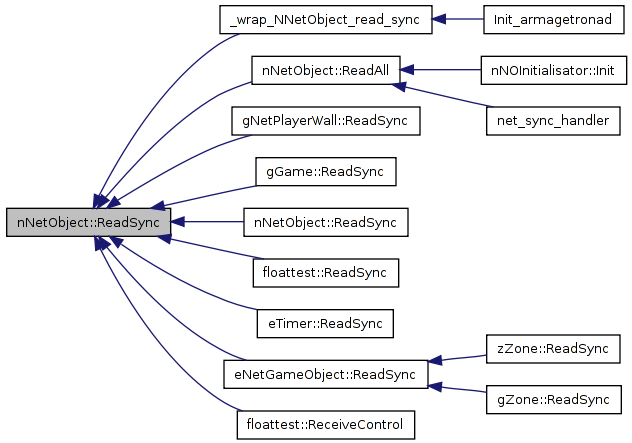
| void nNetObject::WriteSync | ( | nMessage & | m, | |
| int | run | |||
| ) | [virtual] |
Definition at line 1210 of file nNetObject.cpp.
References WriteSync().
01211 { 01212 if ( run == 0 ) 01213 { 01214 WriteSync( m ); 01215 } 01216 }

| void nNetObject::ReadSync | ( | nMessage & | m, | |
| int | run | |||
| ) | [virtual] |
Definition at line 1218 of file nNetObject.cpp.
References ReadSync().
01219 { 01220 if ( run == 0 ) 01221 { 01222 ReadSync( m ); 01223 } 01224 }
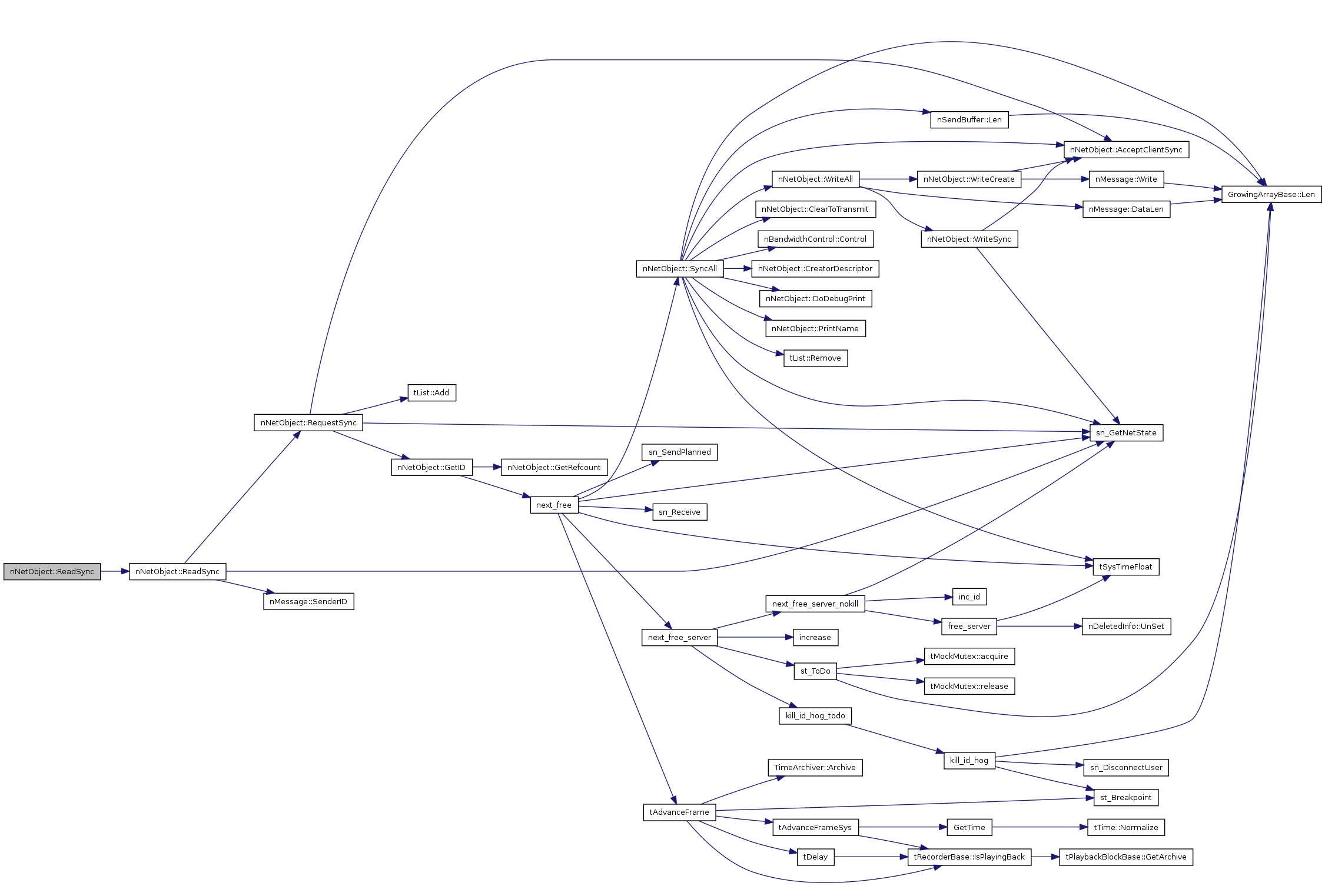
| bool nNetObject::SyncIsNew | ( | nMessage & | m | ) | [virtual] |
Reimplemented in eNetGameObject, eTeam, SwigDirector_NNetObject, gCycle, and gNetPlayerWall.
Definition at line 692 of file nNetObject.cpp.
References lastSyncID_, nMessage::MessageIDBig(), and sn_Update().
Referenced by net_sync_handler(), gNetPlayerWall::SyncIsNew(), and eNetGameObject::SyncIsNew().
00692 { 00693 unsigned long int bigID = m.MessageIDBig(); 00694 // sn_Update(global_lastSync,bigID); 00695 return sn_Update(lastSyncID_,bigID); 00696 }


| void nNetObject::WriteCreate | ( | nMessage & | m | ) | [virtual] |
Reimplemented in eNetGameObject, eTeam, floattest, deptest, deptest, SwigDirector_NNetObject, gCycle, gNetPlayerWall, gZone, zShape, zShapeCircle, zShapePolygon, and zZone.
Definition at line 1300 of file nNetObject.cpp.
References AcceptClientSync(), con, id, owner, and nMessage::Write().
Referenced by _wrap_NNetObject_write_create(), WriteAll(), gNetPlayerWall::WriteCreate(), WriteCreate(), deptest::WriteCreate(), floattest::WriteCreate(), eTeam::WriteCreate(), and eNetGameObject::WriteCreate().
01300 { 01301 m.Write(id); 01302 m.Write(owner); 01303 01304 // store the info needed in the destructor 01305 sn_netObjects_AcceptClientSync[id]=this->AcceptClientSync(); 01306 01307 if (deb_net) 01308 con << "Sending creation message for nNetObject " << id << "\n"; 01309 }


| void nNetObject::WriteCreate | ( | nMessage & | m, | |
| int | run | |||
| ) | [virtual] |
Definition at line 1226 of file nNetObject.cpp.
References WriteCreate().
01227 { 01228 if ( run == 0 ) 01229 { 01230 WriteCreate( m ); 01231 } 01232 }

| void nNetObject::ReadCreate | ( | nMessage & | m, | |
| int | run | |||
| ) | [virtual] |
Definition at line 1234 of file nNetObject.cpp.
References tASSERT.
Referenced by ReadAll().
01235 { 01236 // run == 0 would call the constructor, but run == 0 never happens. 01237 tASSERT( run > 0 ); 01238 }

| void nNetObject::WriteAll | ( | nMessage & | m, | |
| bool | create | |||
| ) |
Definition at line 1240 of file nNetObject.cpp.
References nMessage::DataLen(), WriteCreate(), and WriteSync().
Referenced by nBandwidthTaskCreate::DoExecute(), nBandwidthTaskSync::DoExecute(), and SyncAll().
01241 { 01242 int lastLen = -1; 01243 int run = 0; 01244 01245 // write as long as the read functions do something 01246 while ( m.DataLen() > lastLen ) 01247 { 01248 lastLen = m.DataLen(); 01249 if ( create ) 01250 { 01251 WriteCreate(m,run); 01252 } 01253 01254 WriteSync(m,run); 01255 ++run; 01256 } 01257 }

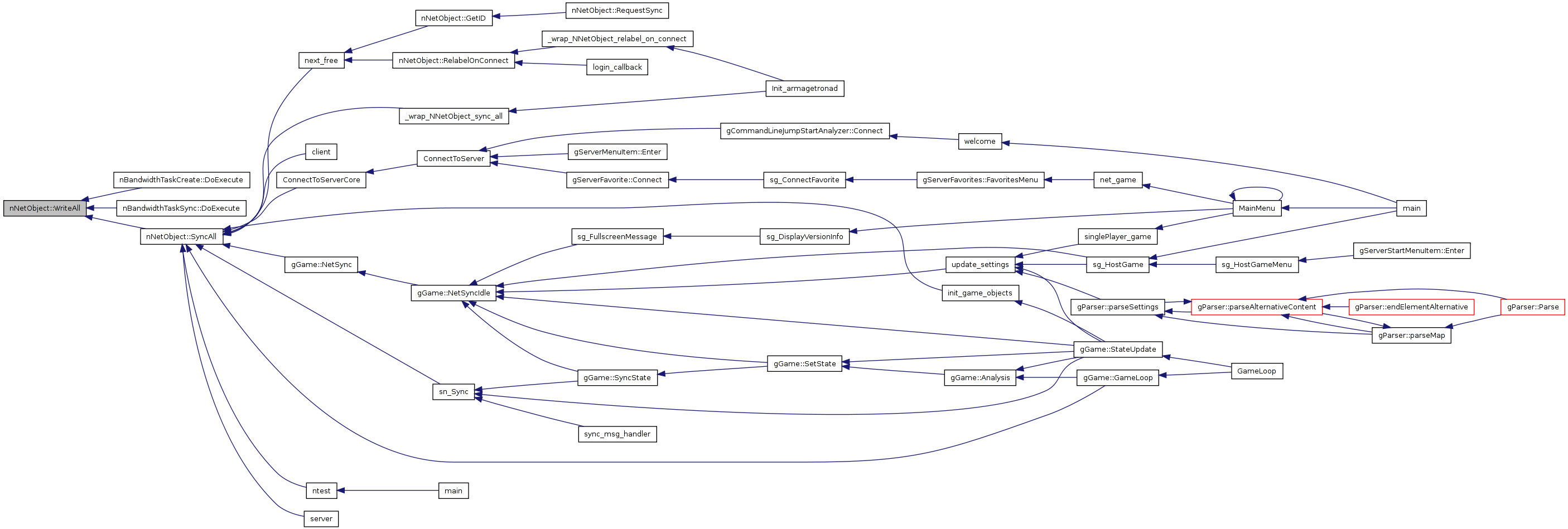
| void nNetObject::ReadAll | ( | nMessage & | m, | |
| bool | create | |||
| ) |
Definition at line 1259 of file nNetObject.cpp.
References ReadCreate(), nMessage::ReadSoFar(), and ReadSync().
Referenced by nNOInitialisator< T >::Init(), and net_sync_handler().
01260 { 01261 int lastRead = -1; 01262 int run = 0; 01263 01264 // read as long as the read functions do something 01265 while ( m.ReadSoFar() > lastRead ) 01266 { 01267 lastRead = m.ReadSoFar(); 01268 if ( create && run > 0 ) 01269 { 01270 ReadCreate(m,run); 01271 } 01272 01273 ReadSync(m,run); 01274 ++run; 01275 } 01276 }
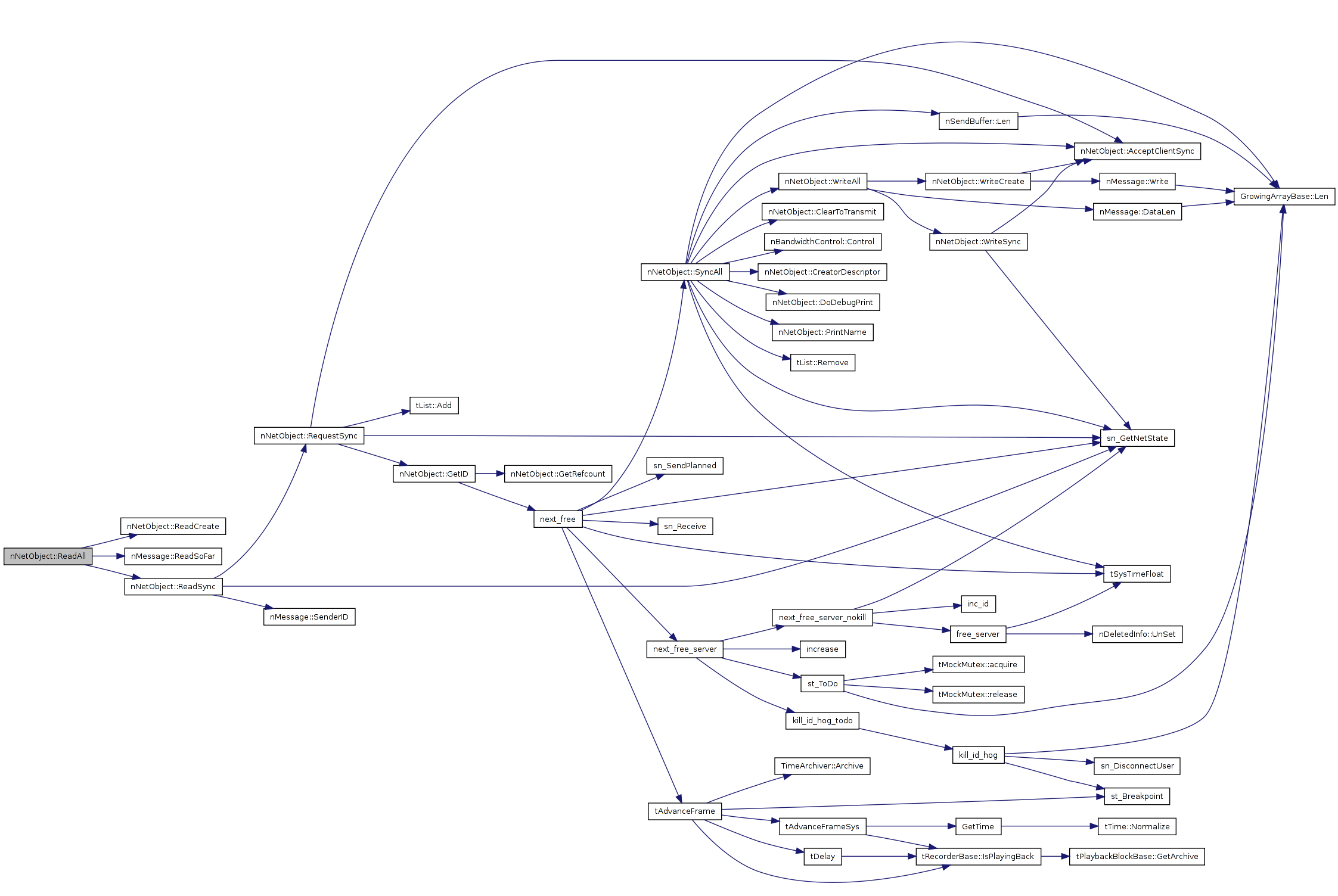

| int nNetObject::SyncedUser | ( | ) | [static, protected] |
returns the user that the current WriteSync() is intended for
Definition at line 1520 of file nNetObject.cpp.
Referenced by eTimer::WriteSync().
01521 { 01522 return sn_syncedUser; 01523 }

| nMessage * nNetObject::NewControlMessage | ( | ) | [protected] |
Definition at line 1407 of file nNetObject.cpp.
References net_control, and nMessage::Write().
Referenced by ePlayerNetID::CreateNewTeamWish(), floattest::SendControl(), eNetGameObject::SendControl(), and ePlayerNetID::SetTeamWish().
01407 { 01408 nMessage *m=new nMessage(net_control); 01409 m->Write(id); 01410 return m; 01411 }


| void nNetObject::ReceiveControlNet | ( | nMessage & | m | ) | [virtual] |
Reimplemented in eNetGameObject, ePlayerNetID, eTeam, and SwigDirector_NNetObject.
Definition at line 1394 of file nNetObject.cpp.
References nCLIENT, RequestSync(), sn_GetNetState(), and tERR_ERROR.
Referenced by _wrap_NNetObject_receive_control_net(), and net_control_handler().
01394 { 01395 #ifdef DEBUG 01396 if (sn_GetNetState()==nCLIENT) 01397 tERR_ERROR("rec_cont should not be called client-side!"); 01398 #endif 01399 01400 // after control is received, we better sync this object with 01401 // the clients: 01402 01403 RequestSync(); 01404 }
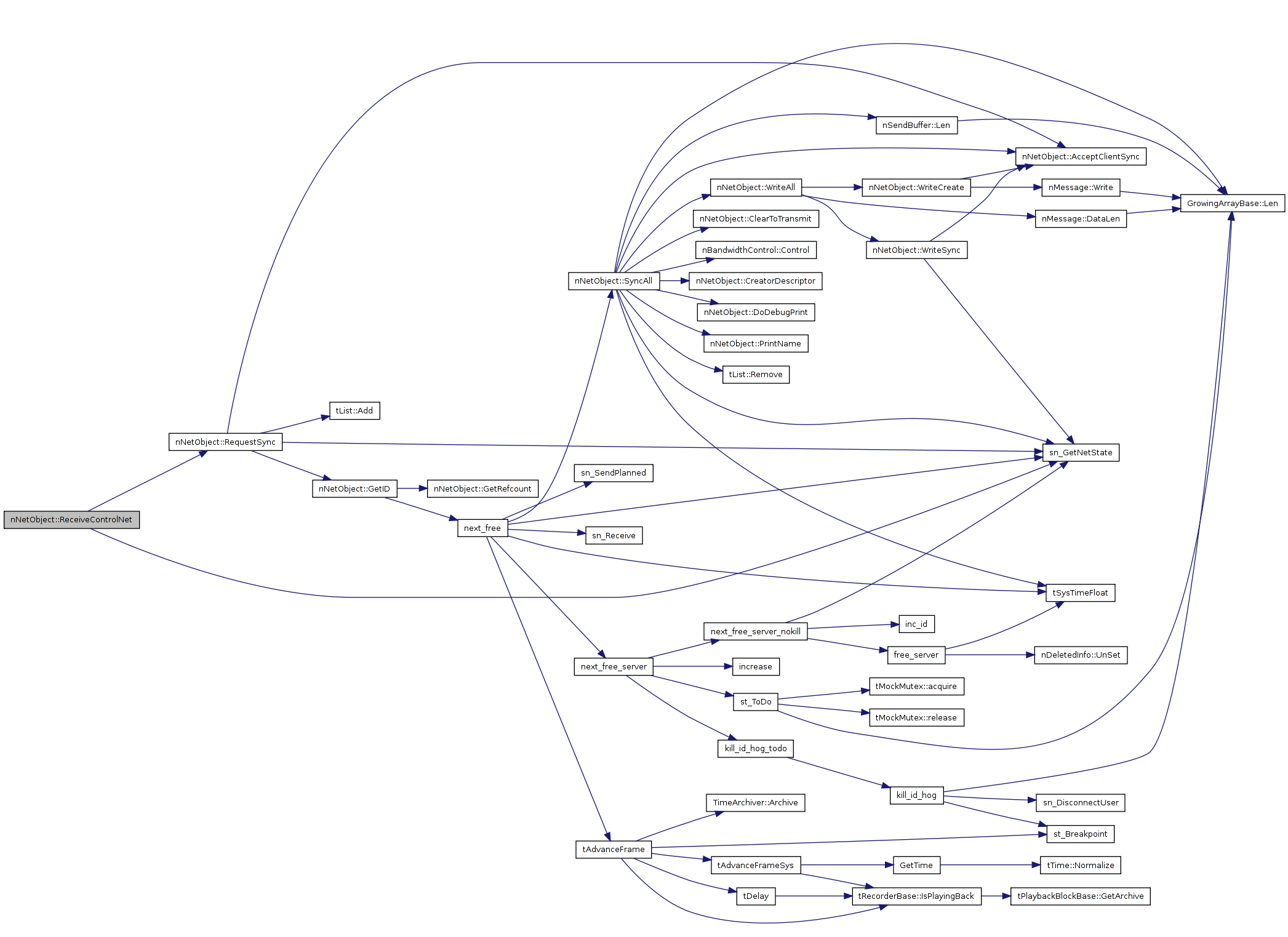

| bool nNetObject::AcceptClientSync | ( | ) | const [virtual] |
Reimplemented in ePlayerNetID, eTeam, floattest, deptest, floattest, deptest, and SwigDirector_NNetObject.
Definition at line 1497 of file nNetObject.cpp.
Referenced by _wrap_NNetObject_accept_client_sync(), ClearKnows(), DoBroadcastExistence(), net_sync_handler(), RequestSync(), SyncAll(), WriteCreate(), and WriteSync().
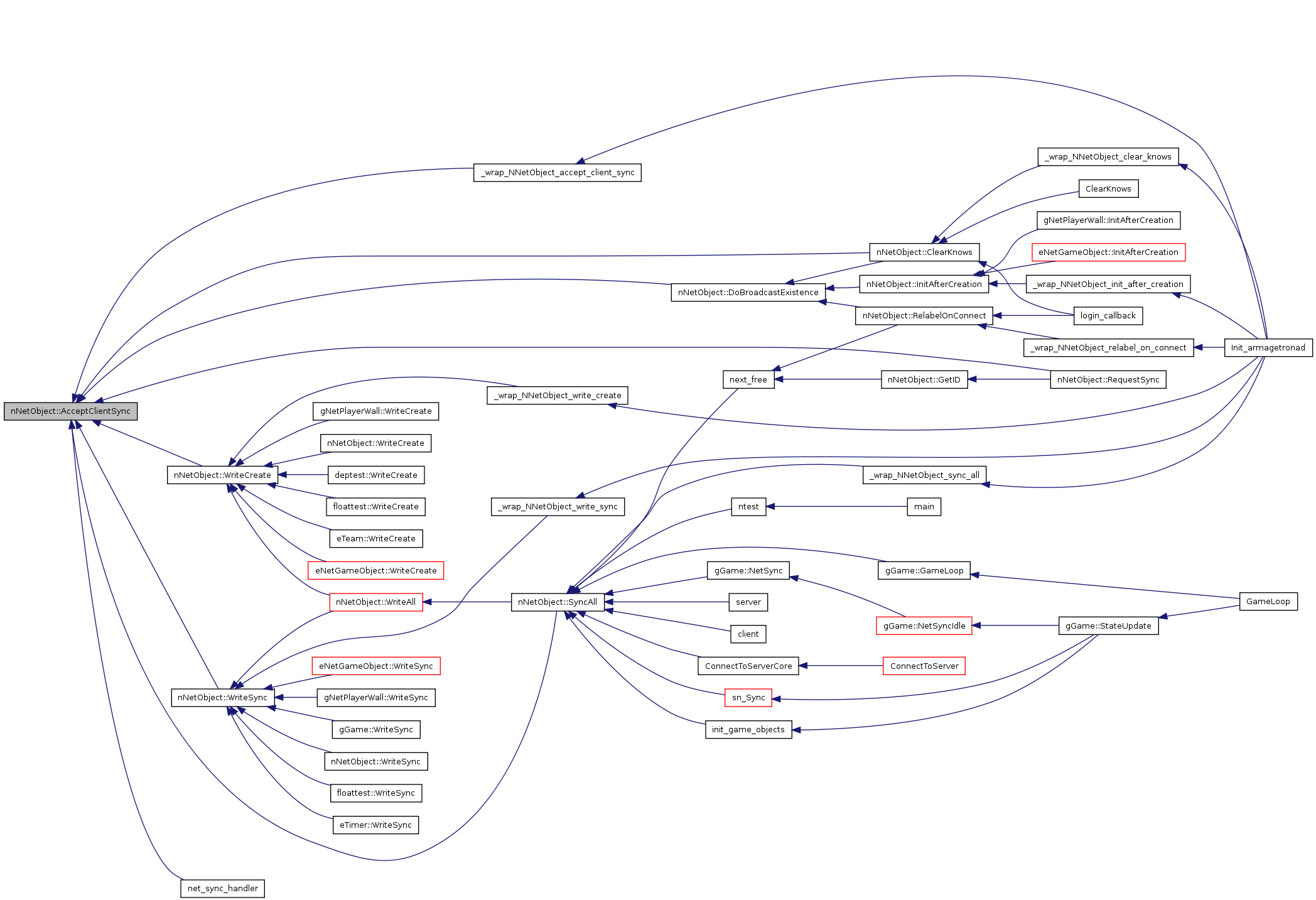
| void nNetObject::GetID | ( | ) |
Definition at line 1311 of file nNetObject.cpp.
References GetRefcount(), nNetObjectRegistrar::id, next_free(), nNetObjectRegistrar::object, owner, sn_netObjects, and tERR_ERROR.
Referenced by RequestSync().
01312 { 01313 if ( !id && GetRefcount() >= 0 ) 01314 { 01315 if ( bool( sn_Registrar ) && this == sn_Registrar->object ) 01316 { 01317 id = sn_Registrar->id; 01318 } 01319 else 01320 { 01321 id = next_free(); 01322 } 01323 01324 if (sn_netObjects[id]) 01325 tERR_ERROR("Dublicate nNetObject id " << id); 01326 01327 sn_netObjectsOwner[id]=owner; 01328 sn_netObjects_AcceptClientSync[id]=false; 01329 01330 sn_netObjects[id]=this; 01331 } 01332 }
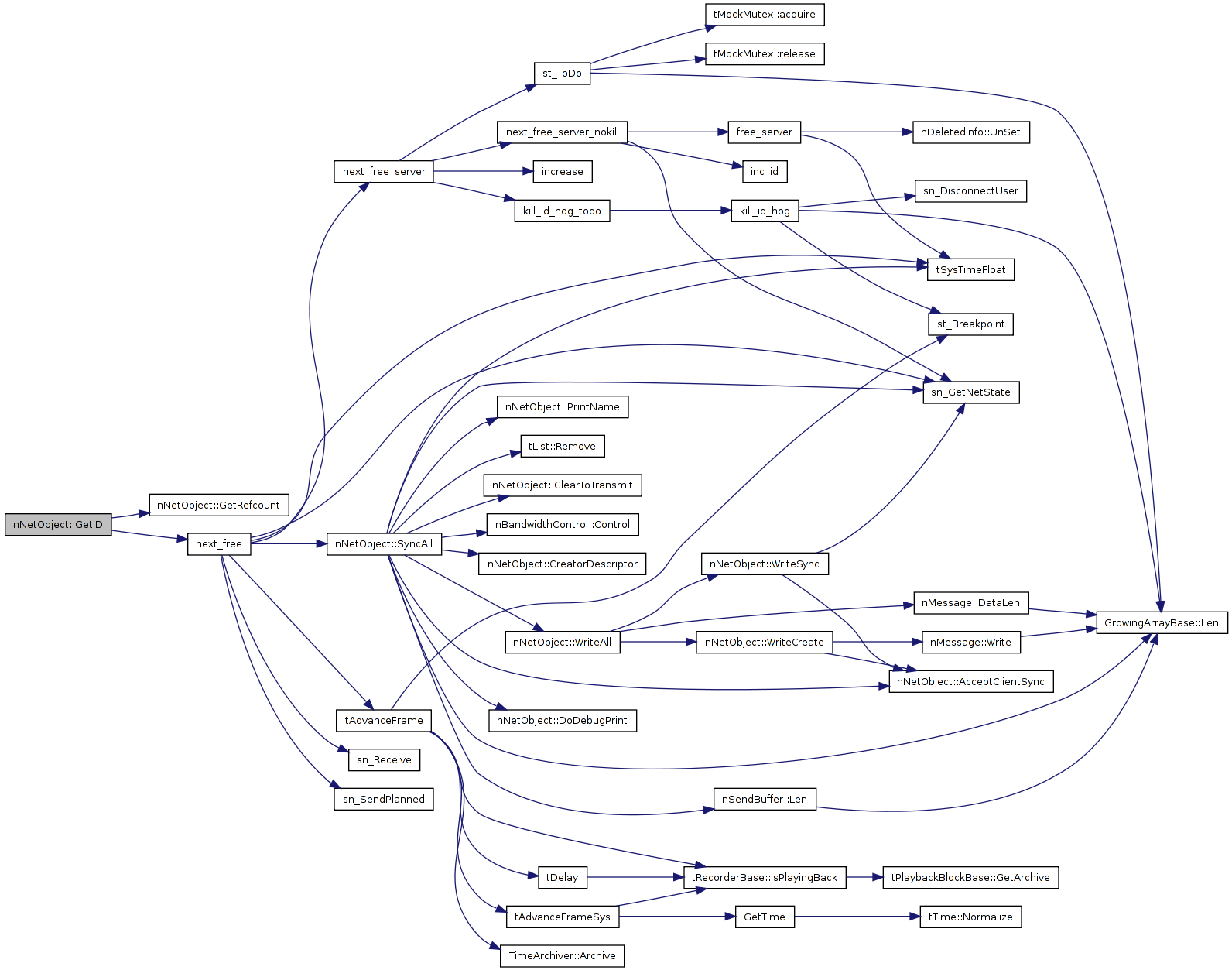

| void nNetObject::RequestSync | ( | bool | ack = true |
) |
Reimplemented in gCycleMovement.
Definition at line 1354 of file nNetObject.cpp.
References AcceptClientSync(), tList< T, MALLOC, REFERENCE >::Add(), GetID(), knowsAbout, MAXCLIENTS, nCLIENT, nNetObject::nKnowsAboutInfo::nextSyncAck, owner, sn_GetNetState(), sn_myNetID, syncListID_, nNetObject::nKnowsAboutInfo::syncReq, and tERR_ERROR.
Referenced by eTeam::AddScore(), ePlayerNetID::AddScore(), gNetPlayerWall::BlowHole(), gNetPlayerWall::CopyIntoGrid(), DoBroadcastExistence(), eNetGameObject::eNetGameObject(), eTimer::eTimer(), GameLoop(), gGame::gGame(), gGame::NoLongerGoOn(), ntest(), gWinZoneHack::OnEnter(), gParser::parseZoneArthemis_v1(), eTimer::pause(), ReadSync(), floattest::ReceiveControl(), eNetGameObject::ReceiveControl(), ReceiveControlNet(), gCycleMovement::RequestSync(), eTeam::ResetScore(), ePlayerNetID::SetChatting(), zShape::setColor(), zShape::setRotation2(), eTeam::SetScore(), gGame::SetState(), gGame::StateUpdate(), eTimer::SyncTime(), gBaseZoneHack::Timestep(), ePlayerNetID::Update(), eTeam::UpdateAppearance(), ePlayerNetID::UpdateName(), and eTeam::UpdateProperties().
01354 { 01355 this->GetID(); 01356 01357 #ifdef nSIMULATE_PING 01358 ack=true; 01359 #endif 01360 01361 #ifdef DEBUG 01362 if (sn_GetNetState()==nCLIENT && (!AcceptClientSync() || owner!=::sn_myNetID)) 01363 tERR_ERROR("RequestSync should only be called server-side!"); 01364 #endif 01365 01366 for (int i=MAXCLIENTS;i>=0;i--){ 01367 knowsAbout[i].syncReq=true; 01368 knowsAbout[i].nextSyncAck |=ack; 01369 } 01370 01371 if ( syncListID_ < 0 ) 01372 sn_SyncRequestedObject.Add( this, syncListID_ ); 01373 }
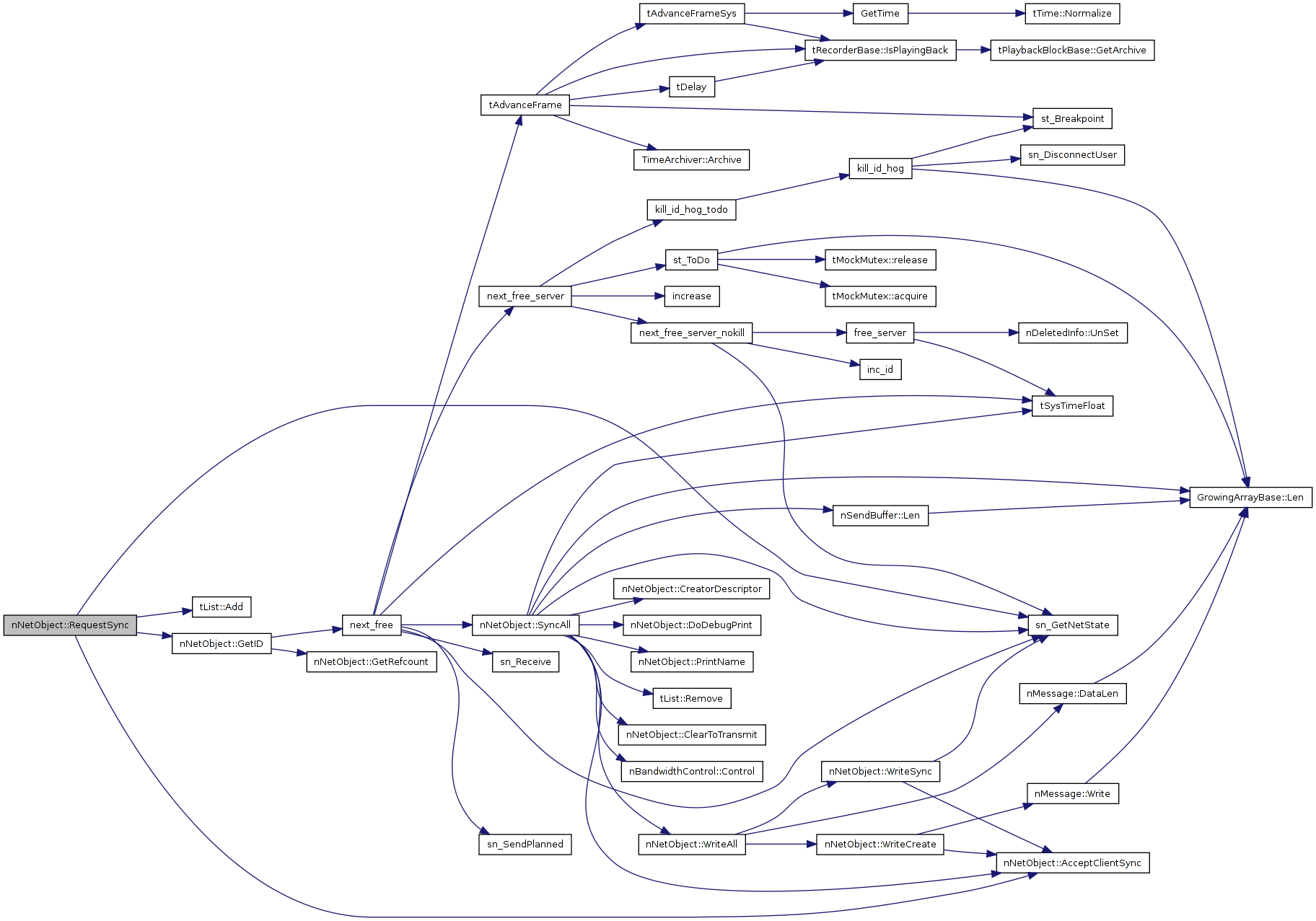
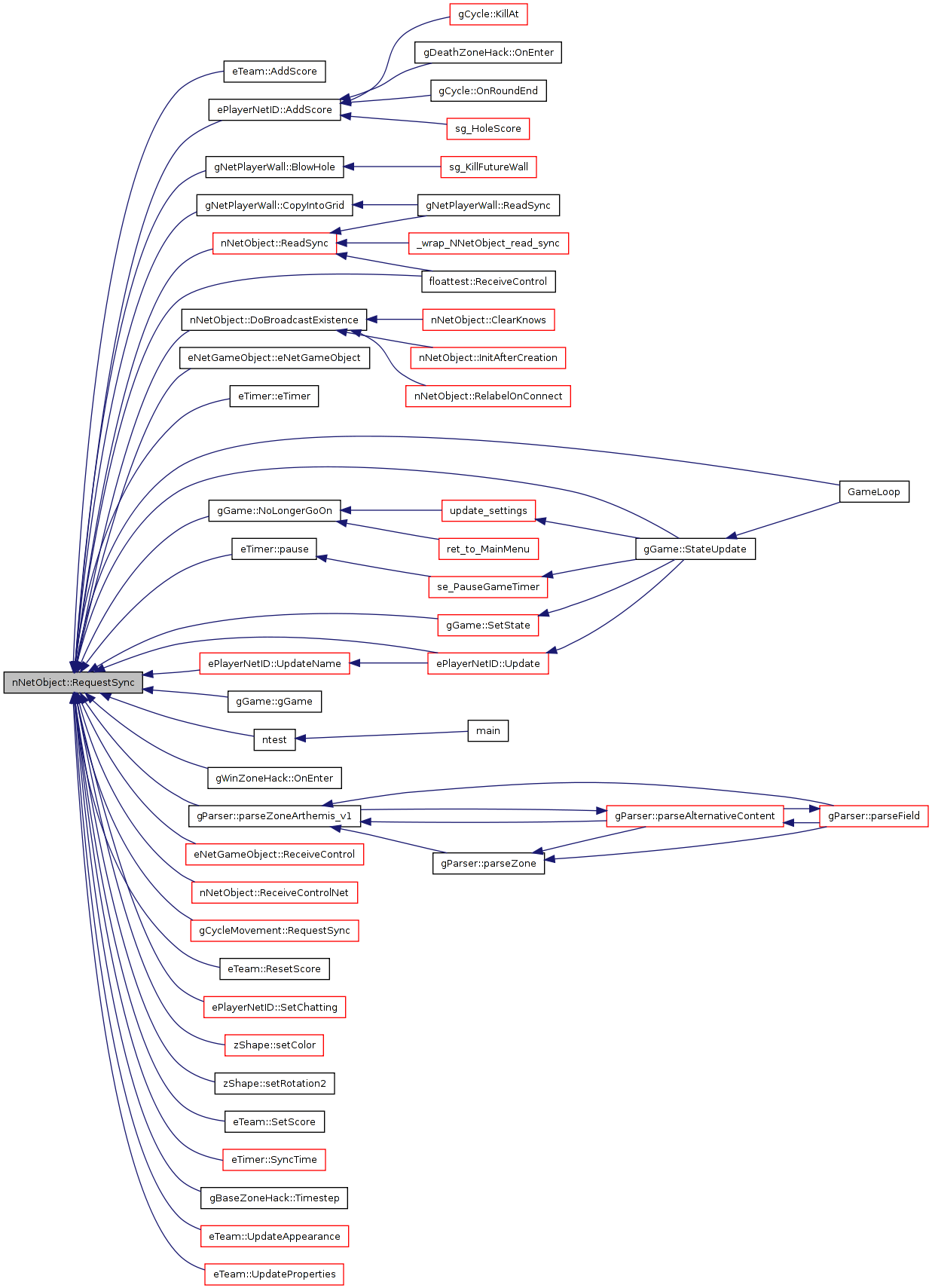
| void nNetObject::RequestSync | ( | int | user, | |
| bool | ack | |||
| ) |
Reimplemented in gCycleMovement.
Definition at line 1335 of file nNetObject.cpp.
References AcceptClientSync(), tList< T, MALLOC, REFERENCE >::Add(), GetID(), knowsAbout, nNetObject::nKnowsAboutInfo::nextSyncAck, nSERVER, owner, sn_GetNetState(), sn_myNetID, syncListID_, nNetObject::nKnowsAboutInfo::syncReq, and tERR_ERROR.
01335 { // only for a single user 01336 #ifdef nSIMULATE_PING 01337 ack=true; 01338 #endif 01339 this->GetID(); 01340 01341 if (sn_GetNetState()==nSERVER || (AcceptClientSync() && owner==::sn_myNetID)){ 01342 knowsAbout[user].syncReq=true; 01343 knowsAbout[user].nextSyncAck |=ack; 01344 } 01345 #ifdef DEBUG 01346 else 01347 tERR_ERROR("RequestSync should only be called server-side!"); 01348 #endif 01349 01350 if ( syncListID_ < 0 ) 01351 sn_SyncRequestedObject.Add( this, syncListID_ ); 01352 }
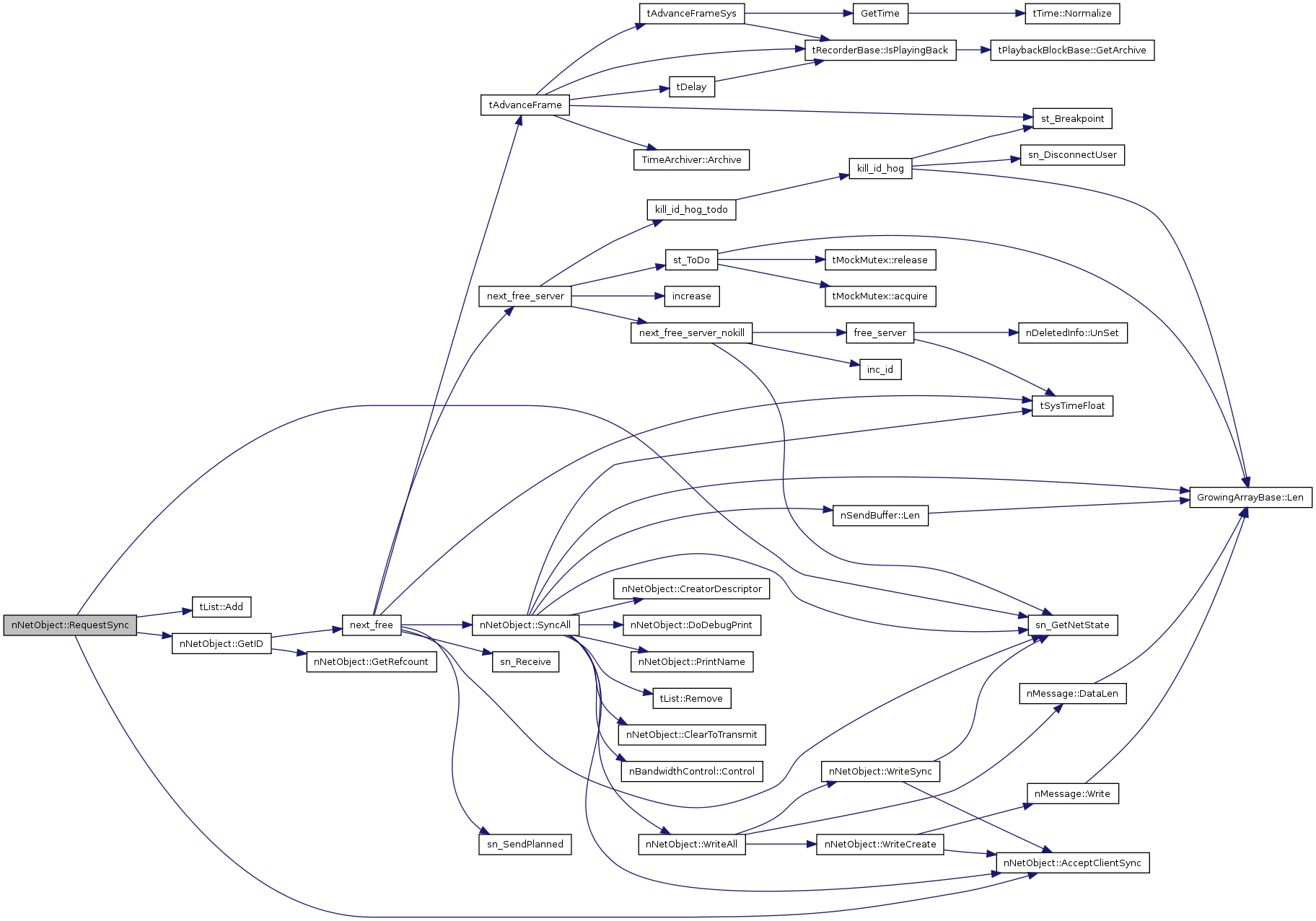
| void nNetObject::SyncAll | ( | ) | [static] |
Definition at line 1525 of file nNetObject.cpp.
References AcceptClientSync(), nConnectionInfo::ackPending, nNetObject::nKnowsAboutInfo::acksPending, nConnectionInfo::bandwidthControl_, ClearToTransmit(), con, nBandwidthControl::Control(), CreatorDescriptor(), DoDebugPrint(), id, knowsAbout, nNetObject::nKnowsAboutInfo::knowsAboutExistence, GrowingArrayBase::Len(), nSendBuffer::Len(), MAXCLIENTS, nCLIENT, net_sync, nNetObject::nKnowsAboutInfo::nextSyncAck, nSERVER, NULL, nWaitForAckSync, PrintName(), tList< T, MALLOC, REFERENCE >::Remove(), nConnectionInfo::sendBuffer_, sn_Connections, sn_GetNetState(), sn_maxNoAck, sn_myNetID, sn_netObjects, sn_SyncRequestedObject, syncListID_, nNetObject::nKnowsAboutInfo::syncReq, tSysTimeFloat(), nBandwidthControl::Usage_Planning, and WriteAll().
Referenced by _wrap_NNetObject_sync_all(), client(), ConnectToServerCore(), gGame::GameLoop(), init_game_objects(), gGame::NetSync(), next_free(), ntest(), server(), and sn_Sync().
01525 { 01526 #ifdef DEBUG 01527 s_DoPrintDebug = false; 01528 01529 static nTimeRolling debugtime = 0; 01530 nTimeRolling time = tSysTimeFloat(); 01531 if (time > debugtime && sn_GetNetState() == nSERVER) 01532 { 01533 debugtime = time+5; 01534 // s_DoPrintDebug = true; 01535 } 01536 #endif 01537 01538 for (int user=MAXCLIENTS;user>=0;user--) 01539 if (is_ready_to_get_objects[user] && 01540 sn_Connections[user].socket && sn_netObjects.Len()>0 && user!=sn_myNetID){ 01541 01542 sn_syncedUser = user; 01543 01544 // send the destroy messages 01545 if (destroyers[user]) 01546 { 01547 // but check whether the opportunity is good (big destroyers message, or a sync packet in the pipe) first 01548 if ( destroyers[user]->DataLen() > 75 || 01549 sn_Connections[user].sendBuffer_.Len() > 0 || 01550 destroyersTime[user] < tSysTimeFloat()-.5 ) 01551 { 01552 destroyers[user]->Send(user); 01553 destroyers[user]=NULL; 01554 } 01555 } 01556 01557 // con << sn_SyncRequestedObject.Len() << "/" << sn_netObjects.Len() << "\n"; 01558 01559 int currentSync = sn_SyncRequestedObject.Len()-1; 01560 while (sn_Connections[user].socket>0 && 01561 sn_Connections[user].bandwidthControl_.CanSend() && 01562 sn_Connections[user].ackPending<sn_maxNoAck && 01563 currentSync >= 0){ 01564 nNetObject *nos = sn_SyncRequestedObject( currentSync ); 01565 01566 if (nos && nos->ClearToTransmit(user) && ( nos == sn_netObjects( nos->id ) ) 01567 && (sn_GetNetState()!=nCLIENT || 01568 nos->AcceptClientSync())) 01569 { 01570 short s = nos->id; 01571 01572 if (// nos->knowsAbout[user].syncReq && 01573 !nos->knowsAbout[user].knowsAboutExistence) 01574 { 01575 if (!nos->knowsAbout[user].acksPending){ 01576 #ifdef DEBUG 01577 //con << "remotely creating object " << s << '\n'; 01578 #endif 01579 /* 01580 con << "creating object " << s << " at user " << user 01581 << " owned by " << sn_netObjects(s)->owner << '\n'; 01582 */ 01583 // send a creation message 01584 01585 tJUST_CONTROLLED_PTR< nMessage > m=new nMessage 01586 (nos->CreatorDescriptor()); 01587 01588 #ifdef DEBUG 01589 if (s == sn_WatchNetID) 01590 sn_WatchMessage = m; 01591 #endif 01592 01593 nos->WriteAll(*m,true); 01594 new nWaitForAckSync(m,user,s); 01595 unsigned long id = m->MessageIDBig(); 01596 m->SendImmediately(user, false); 01597 m->messageIDBig_ = id; 01598 01599 nos->knowsAbout[user].syncReq = false; 01600 } 01601 #ifdef DEBUG 01602 else if (DoDebugPrint()) 01603 { 01604 tString s; 01605 s << "Not remotely creating object "; 01606 nos->PrintName(s); 01607 s << " on user " << user << " again because there is an Ack pending.\n"; 01608 con << s; 01609 } 01610 #endif 01611 } 01612 else if (nos->knowsAbout[user].syncReq 01613 && sn_Connections[user].bandwidthControl_.Control( nBandwidthControl::Usage_Planning ) >50 01614 && nos->knowsAbout[user].acksPending<=1){ 01615 // send a sync 01616 tJUST_CONTROLLED_PTR< nMessage > m = new nMessage(net_sync); 01617 01618 m->Write(s); 01619 nos->WriteAll(*m,false); 01620 nos->knowsAbout[user].syncReq=false; 01621 01622 if (nos->knowsAbout[user].nextSyncAck){ 01623 new nWaitForAckSync(m,user,s); 01624 nos->knowsAbout[user].nextSyncAck=false; 01625 } 01626 #ifndef nSIMULATE_PING 01627 unsigned long id = m->MessageIDBig(); 01628 //m->Send(user,0,false); 01629 m->SendImmediately(user,false); 01630 m->messageIDBig_ = id; 01631 #endif 01632 } 01633 01634 } 01635 01636 currentSync--; 01637 } 01638 01639 sn_syncedUser = -1; 01640 01641 #ifdef DEBUG 01642 bool inc=false; 01643 static int warn=0; 01644 static int nextWarnOverflow=0; 01645 static int nextWarnAck=0; 01646 if (sn_Connections[user].bandwidthControl_.Control( nBandwidthControl::Usage_Planning )<-100){ 01647 if (warn>=nextWarnOverflow) 01648 { 01649 nextWarnOverflow = 2+(warn*17)/16; 01650 con << "Warning! Network overflow: " 01651 << -100-sn_Connections[user].bandwidthControl_.Control( nBandwidthControl::Usage_Planning ) << "\n"; 01652 } 01653 inc=true; 01654 } 01655 if (sn_Connections[user].ackPending>=sn_maxNoAck){ 01656 if (warn>=nextWarnAck) 01657 { 01658 nextWarnAck = 2+(warn*17)/16; 01659 std::cerr << "Warning! Too many acks pending: " 01660 << sn_Connections[user].ackPending << "\n"; 01661 } 01662 inc=true; 01663 } 01664 if (inc) 01665 warn++; 01666 #endif 01667 } 01668 01669 01670 // clear out objects that no longer need to be in the list because 01671 // all requested syncs have been sent 01672 { 01673 for ( int currentSync = sn_SyncRequestedObject.Len()-1; currentSync >= 0; --currentSync ){ 01674 nNetObject *nos = sn_SyncRequestedObject( currentSync ); 01675 01676 if ( nos ) 01677 { 01678 // check if nos can be removed from sync request list 01679 bool canRemove = true; 01680 01681 // check if there is anything preventing the removal 01682 if ( nos == sn_netObjects( nos->id ) ) 01683 { 01684 int start = ( sn_GetNetState() == nSERVER ) ? MAXCLIENTS : 0; 01685 int stop = ( sn_GetNetState() == nSERVER ) ? 1 : 0; 01686 for ( int i = start; i>=stop && canRemove; --i ) 01687 { 01688 const nKnowsAboutInfo& knows = nos->knowsAbout[i]; 01689 if ( sn_Connections[i].socket && knows.syncReq ) 01690 canRemove = false; 01691 } 01692 } 01693 if ( canRemove ) 01694 sn_SyncRequestedObject.Remove( nos, nos->syncListID_ ); 01695 } 01696 } 01697 } 01698 }
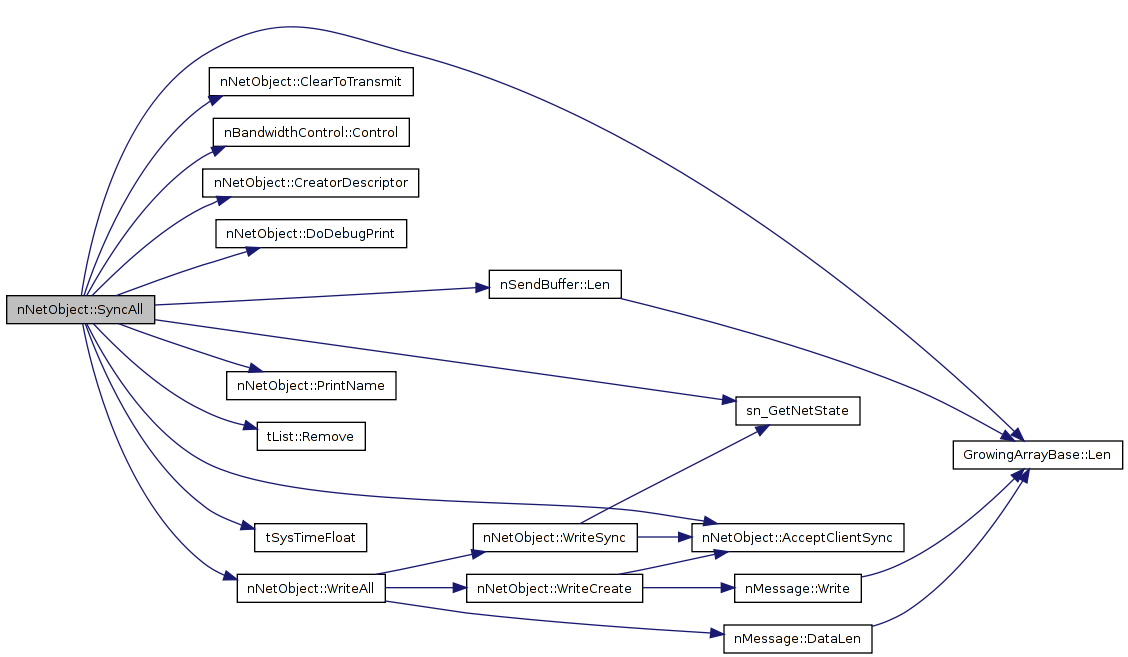
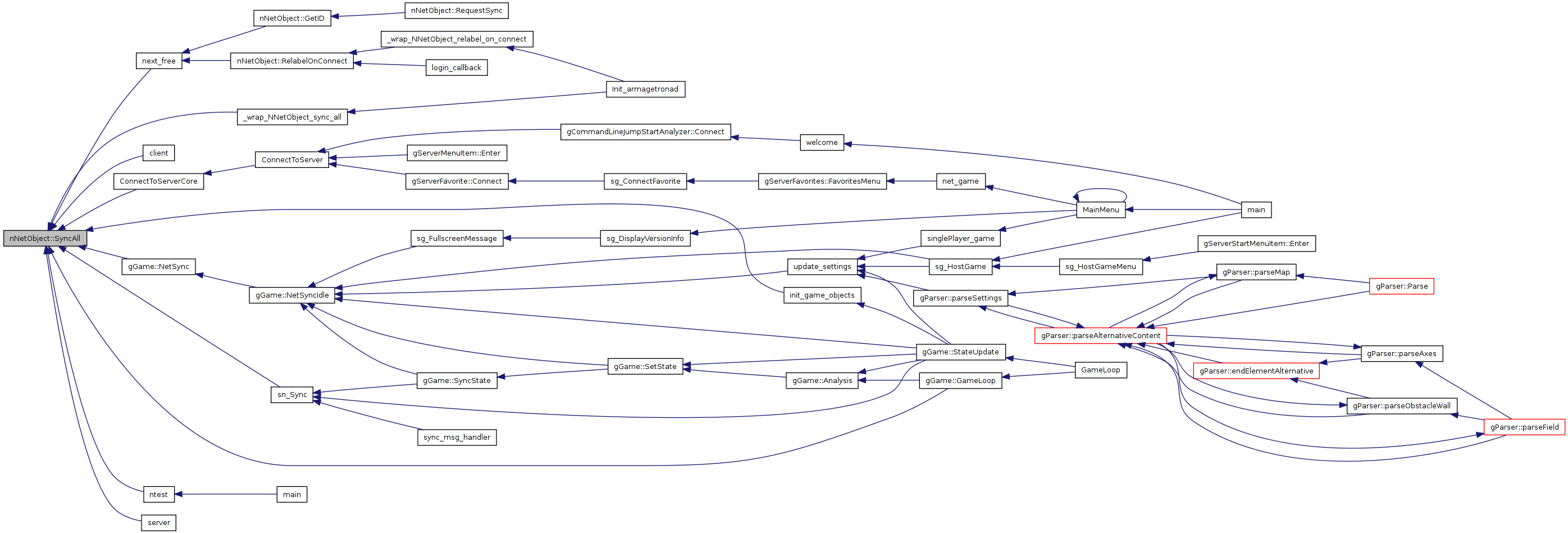
| void nNetObject::ClearAll | ( | ) | [static] |
Reimplemented in ePlayerNetID, and gAIPlayer.
Definition at line 1741 of file nNetObject.cpp.
References ClearAllDeleted(), GrowingArrayBase::Len(), net_clear, NULL, tList< T, MALLOC, REFERENCE >::Remove(), tArray< T, MALLOC >::SetLen(), sn_netObjects, sn_netObjectsOwner, syncListID_, tASSERT, and tNEW.
Referenced by _wrap_NNetObject_clear_all(), cleanup(), ConnectToServerCore(), main(), and net_clear_handler().
01741 { 01742 ClearAllDeleted(); 01743 sn_freedIDs.clear(); 01744 01745 //con << "WARNING! BAD DESIGN. nNetObject::clear all() called.\n"; 01746 int i; 01747 for (i=sn_netObjects.Len()-1;i>=0;i--) 01748 if (tJUST_CONTROLLED_PTR< nNetObject > no=sn_netObjects(i)){ 01749 sn_netObjects(i)=NULL; 01750 sn_netObjectsOwner(i)=0; 01751 no->id = 0; 01752 } 01753 sn_netObjects.SetLen(0); 01754 sn_netObjectsOwner.SetLen(0); 01755 01756 for (i=sn_SyncRequestedObject.Len()-1;i>=0;i--) 01757 { 01758 nNetObject * n = sn_SyncRequestedObject[i]; 01759 tASSERT(n); 01760 sn_SyncRequestedObject.Remove( n, n->syncListID_ ); 01761 } 01762 01763 (tNEW(nMessage)(net_clear))->BroadCast(); // just to make sure.. 01764 }
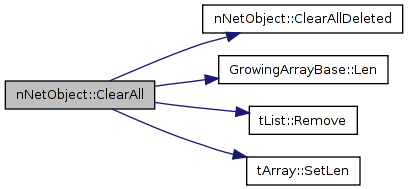

| void nNetObject::ClearAllDeleted | ( | ) | [static] |
Definition at line 1722 of file nNetObject.cpp.
References MAXCLIENTS, NULL, and sn_Connections.
Referenced by _wrap_NNetObject_clear_all_deleted(), gAITeam::BalanceWithAIs(), ClearAll(), gGame::StateUpdate(), and ePlayerNetID::Update().
01723 { 01724 // forget about objects that were deleted in the past. The swap trick is to 01725 // avoid that the objects try to remove themselves from the list while it is cleared. 01726 nDeletedInfos swap; 01727 swap.swap( sn_netObjectsDeleted ); 01728 swap.clear(); 01729 01730 // send out object deletion messages 01731 for ( int i = MAXCLIENTS;i>=0;i--) 01732 { 01733 if ( sn_Connections[i].socket && destroyers[i] ) 01734 { 01735 destroyers[i]->Send(i); 01736 destroyers[i] = NULL; 01737 } 01738 } 01739 }

| void nNetObject::ClearKnows | ( | int | user, | |
| bool | clear | |||
| ) | [static] |
Definition at line 1767 of file nNetObject.cpp.
References AcceptClientSync(), ActionOnQuit(), DoBroadcastExistence(), knowsAbout, MAXCLIENTS, NULL, owner, nNetObject::nKnowsAboutInfo::Reset(), sn_myNetID, sn_netObjects, and sn_netObjectsOwner.
Referenced by _wrap_NNetObject_clear_knows(), ClearKnows(), and login_callback().
01767 { 01768 if (0<=user && user <=MAXCLIENTS){ 01769 is_ready_to_get_objects[user]=false; 01770 for (int i=sn_netObjects.Len()-1;i>=0;i--){ 01771 nNetObject *no=sn_netObjects(i); 01772 if (no){ 01773 no->knowsAbout[user].Reset(); 01774 01775 no->DoBroadcastExistence(); // immediately transfer the thing 01776 01777 if (clear){ 01778 if (no->owner==user && user!=sn_myNetID){ 01779 if (no->ActionOnQuit()) 01780 sn_netObjects(i)=NULL; // destroy it 01781 else{ 01782 no->owner=::sn_myNetID; // or make it mine. 01783 sn_netObjectsOwner(i)=::sn_myNetID; 01784 if (no->AcceptClientSync()){ 01785 tControlledPTR< nNetObject > bounce( no ); // destroy it, if noone wants it 01786 } 01787 } 01788 } 01789 } 01790 } 01791 } 01792 } 01793 }
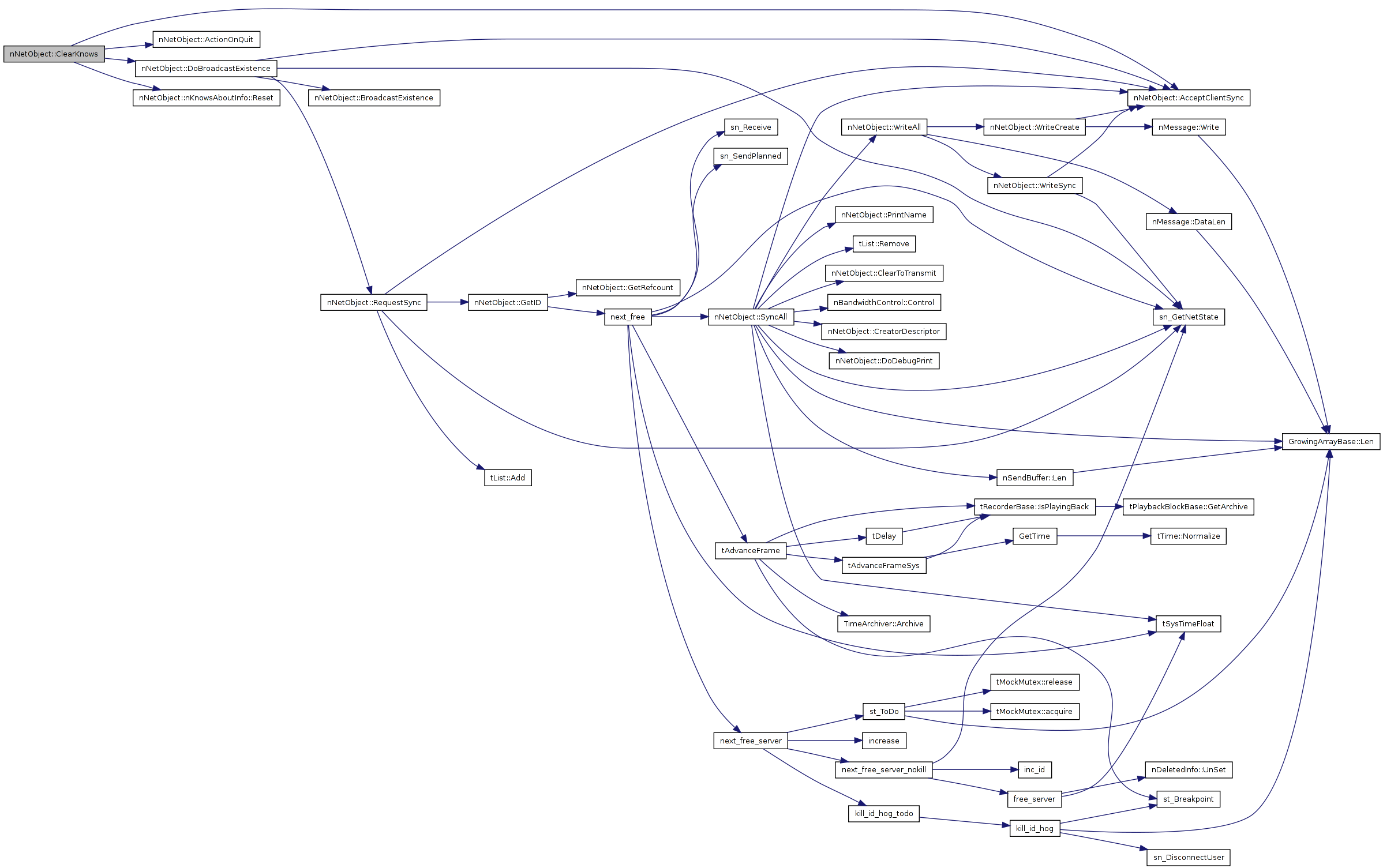

| void nNetObject::RelabelOnConnect | ( | ) | [static] |
Definition at line 1811 of file nNetObject.cpp.
References DoBroadcastExistence(), id, knowsAbout, GrowingArrayBase::Len(), MAXCLIENTS, nCLIENT, next_free(), NULL, owner, ready, nNetObject::nKnowsAboutInfo::Reset(), sn_GetNetState(), sn_myNetID, sn_netObjects, and st_Breakpoint().
Referenced by _wrap_NNetObject_relabel_on_connect(), and login_callback().
01811 { 01812 if (sn_GetNetState()==nCLIENT){ 01813 tArray<tJUST_CONTROLLED_PTR<nNetObject> > sn_netObjects_old; 01814 01815 // transfer the sn_netObjects to sn_netObjects_old: 01816 int i; 01817 for (i=sn_netObjects.Len()-1;i>=0;i--){ 01818 sn_netObjects_old[i]=sn_netObjects(i); 01819 sn_netObjects(i)=NULL; 01820 sn_netObjectsOwner[i]=0; 01821 } 01822 01823 // assign new id's and transfer them back to sn_netObjects: 01824 for (i=sn_netObjects_old.Len()-1;i>=0;i--){ 01825 nNetObject *no = sn_netObjects_old(i); 01826 if (no){ 01827 unsigned short id=next_free(); 01828 01829 #ifdef DEBUG 01830 sn_BreakOnObjectID( id ); 01831 #endif 01832 01833 #ifdef DEBUG 01834 //con << "object " <<i << " gets new id " << id << '\n'; 01835 #endif 01836 no->id=id; 01837 no->owner=::sn_myNetID; 01838 sn_netObjectsOwner[id]=::sn_myNetID; 01839 for (int j=MAXCLIENTS;j>=0;j--){ 01840 no->knowsAbout[j].Reset(); 01841 no->DoBroadcastExistence(); 01842 } 01843 01844 if (sn_netObjects[id]) 01845 st_Breakpoint(); 01846 01847 sn_netObjects[id]=no; 01848 sn_netObjects_old(i)=NULL; 01849 } 01850 } 01851 } 01852 (new nMessage(ready))->Send(0); 01853 is_ready_to_get_objects[0]=true; 01854 }
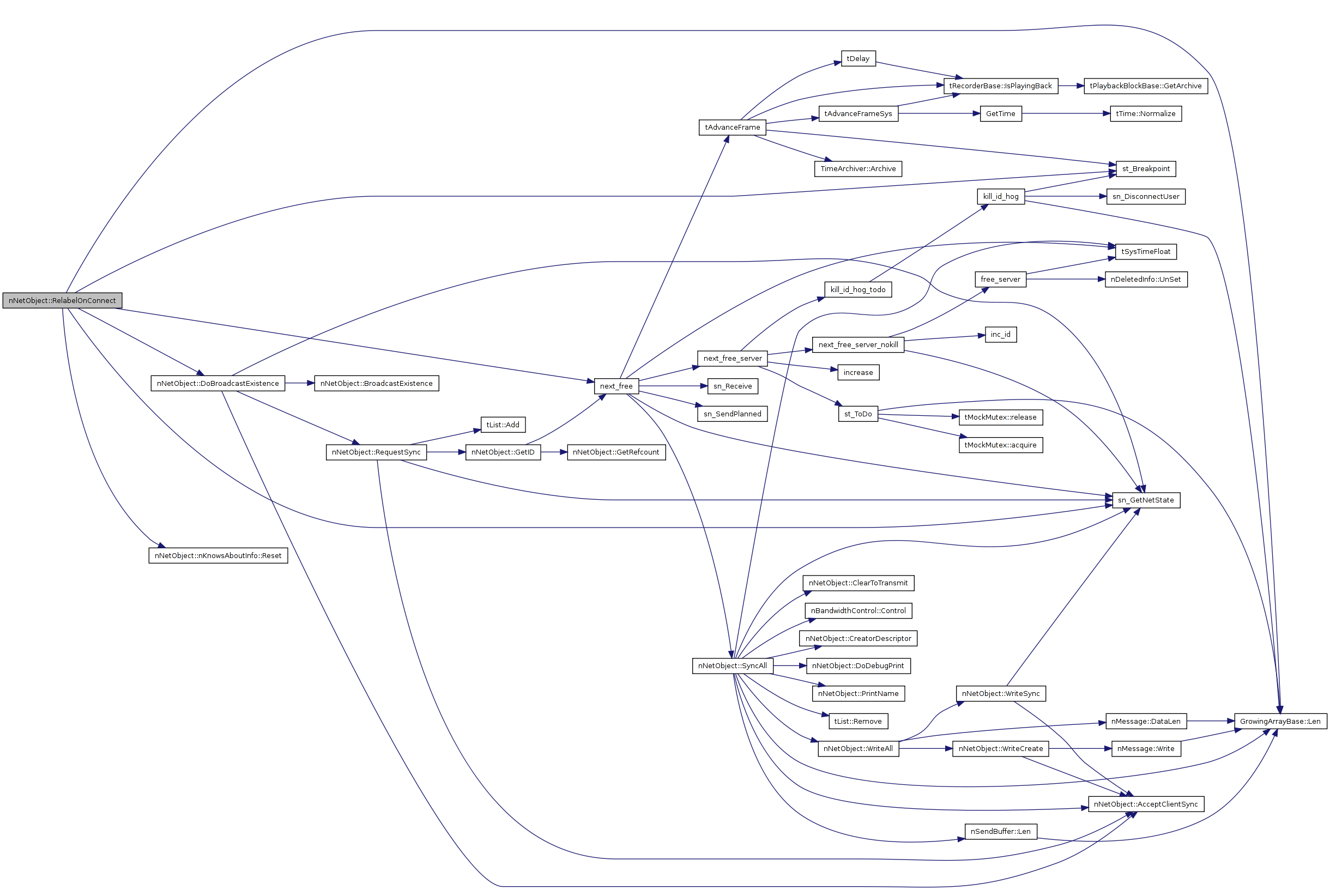

friend class nWaitForAckSync [friend] |
bool nNetObject::createdLocally [private] |
Definition at line 54 of file nNetObject.h.
Referenced by GetRefcount(), nNetObject(), Owned(), Release(), ReleaseOwnership(), TakeOwnership(), and ~nNetObject().
unsigned long int nNetObject::lastSyncID_ [private] |
unsigned short nNetObject::id [private] |
Reimplemented in gNetPlayerWall.
Definition at line 58 of file nNetObject.h.
Referenced by deptest::deptest(), handle_chat_client(), ID(), net_control_handler(), net_destroy_handler(), net_sync_handler(), PrintName(), RelabelOnConnect(), sync_ack_handler(), SyncAll(), and WriteCreate().
int nNetObject::refCtr_ [mutable, private] |
Definition at line 61 of file nNetObject.h.
Referenced by AddRef(), GetRefcount(), Release(), and ~nNetObject().
unsigned short nNetObject::owner [private] |
Definition at line 64 of file nNetObject.h.
Referenced by ClearKnows(), floattest::debug_out(), deptest::deptest(), DoBroadcastExistence(), floattest::floattest(), GetID(), nNetObject(), Object(), Owner(), floattest::ReadSync(), floattest::ReceiveControl(), Register(), RelabelOnConnect(), RequestSync(), WriteCreate(), deptest::~deptest(), floattest::~floattest(), and ~nNetObject().
int nNetObject::syncListID_ [private] |
Definition at line 73 of file nNetObject.h.
Referenced by ClearAll(), nNetObject(), RequestSync(), SyncAll(), and ~nNetObject().
nKnowsAboutInfo nNetObject::knowsAbout[MAXCLIENTS+2] [protected] |
Definition at line 103 of file nNetObject.h.
Referenced by nWaitForAckSync::AckExtraAction(), ClearKnows(), DoBroadcastExistence(), HasBeenTransmitted(), nNetObject(), nWaitForAckSync::nWaitForAckSync(), ReadSync(), RelabelOnConnect(), RequestSync(), SyncAll(), syncRequested(), and ~nNetObject().
 1.5.4
1.5.4